Web3 Handbook
This handbook offers a broad yet structured overview of the Web3 space — not from a purely technical or academic lens, but from the perspective of an active investor, innovator, or Web3-curious reader seeking to understand the foundational ideas shaping this ecosystem. While long-form (~90 minutes read), it remains a high-level introduction. Feel free to read it end-to-end or dive into the sections most relevant to you. It does not aim to cover every aspect of Web3, but rather highlights the themes we believe are most important right now.
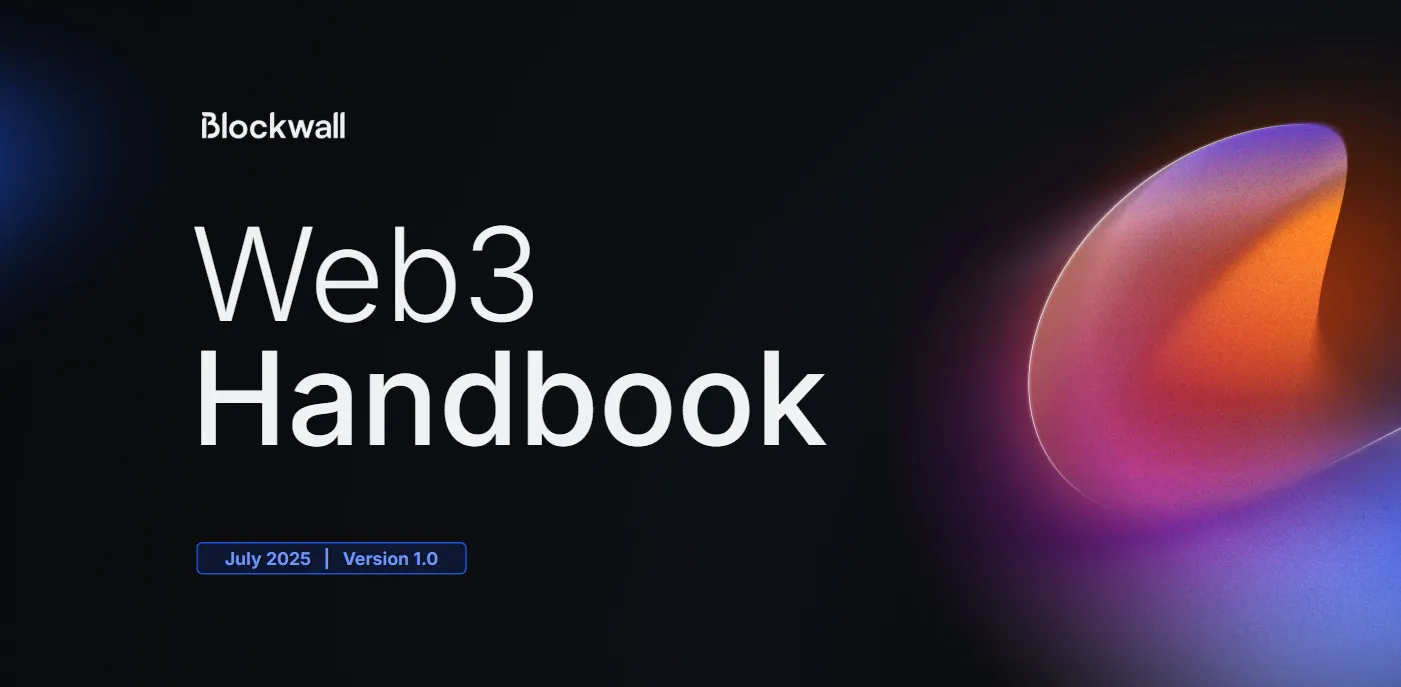
Table of Contents
- Introduction
- Why Web3 Matters
2.1 Web 1.0: The Internet’s Beginnings
2.2 Web 2.0: The New Reality
2.3 Web 3.0: Returning to Old Ideas
- What are Crypto and Web3?
3.1 The Difference Between Crypto and Web3
3.2 Blockchains
- Web3’s Potential to Disrupt
4.1 Finance
4.2 Payments & Stablecoins
4.3 Physical Infrastructure Networks
4.4 Social
4.5 Digital Ownership
4.6 Privacy
4.7 Gaming
- Why Now is the Right Time to Invest?
5.1 Scalability
5.2 Improved User Experience
5.3 Institutional Adoption
5.4 Regulation
- Outlook: The Convergence of Technologies
6.1 Web3 x Artificial Intelligence
6.2 Web3 x The Internet of Things (IoT)
6.3 Web3 x Metaverse
- Our Vision for 2035
- Bonus: Investing in Traditional Firms vs. Web3
8.1 A Brief Introduction to Tokens
8.2 Traditional vs. Crypto Businesses
8.3 Tokenomics
8.4 MakerDAO as an Example of Effective Tokenomics
8.5 Final Considerations
1. Introduction
The concept of 'Web3' remains unclear to many - even though it could become one of the most transformative technological shifts of the 21st century.
Often associated with digital currencies or digital collectibles (NFTs), the term 'Web3' is frequently dismissed without a deeper look at the underlying technology. This handbook aims to change that.
In the following pages, we’ll provide a clear, high-level overview of crypto and Web3, the breakthrough technologies behind them, their guiding principles, and how they’re reshaping the internet.
At Blockwall, we’ve viewed blockchain technologies and the emergence of blockchain-based applications as the next evolution of the internet since we raised our first fund in 2018. That conviction remains core to our investment thesis.
By the end of this handbook, you’ll understand how we conceptualize this emerging industry, the investment case behind Web3 companies, and why now is a uniquely interesting time to engage and start investing in the space.
Let’s begin by briefly revisiting how the internet evolved over the last 40 years - to better understand why Web3 matters today.
2. Why Web3 Matters

2.1 Web 1.0: The Internet’s Beginnings
Undoubtedly, the internet stands as one of the most transformative technological revolutions of the twentieth century. Its earliest iteration, commonly referred to as Web 1.0, relied on foundational protocols such as HTTP (Web) and SMTP (Email) to enable users to share and access information globally and instantaneously. However, this version primarily comprised static websites that lacked the interactive features of today’s internet, as it did not facilitate direct user-to-user engagement. Consequently, this phase became widely recognized as the "read-only web" - a one-way exchange of information dominated by content consumption rather than collaboration.
The infrastructure of Web 1.0 was defined by its open, permissionless nature, ensuring universal and equal access for users worldwide. Innovations built on its protocols and networks remained fully owned by their creators - so long as they adhered to legal standards, their digital properties were immune to removal or interference by third parties.
This was the case because users often created and hosted their own content (i.e. static websites) directly on their own servers, without any intermediaries in between.
Looking back, this era brought to life many applications that significantly changed the way we live. Examples include the first graphical web browsers like Mosaic and Netscape, search engines like Google and Yahoo, and e-commerce marketplaces like Amazon and eBay.
But in the following 20 years, things changed - for better and for worse.
2.2 Web 2.0: The New Reality
The Evolution from Web 1.0 to Web 2.0
Beginning in the mid-2000s, the rise of early social networks revolutionized how the average user interacted with the internet. These platforms empowered anyone to publish content effortlessly online, fostering connections between users and enabling direct engagement with shared material - transforming the internet into a dynamic, participatory space. This shift earned the era its designation as the read-write web, or Web 2.0.
Over time, social networks experienced significant growth, with Facebook currently being the most used platform, boasting around 3 billion monthly active users (MAU). Ultimately, this led to a handful of companies (those controlling the networks) to control a disproportionate amount of the traffic generated on the web.
The Ad-Driven Revenue Model and Centralization
To monetize their platforms, tech companies adopted the ad-driven revenue model. In this framework, networks aggregate vast quantities of user data - tracking behaviors, preferences, and interactions - to construct social graph profiles that map users’ digital identities and connections. These profiles are then monetized by enabling advertisers to target hyper-specific audiences.
Most of the revenue generated through this model goes to the network operators (e.g., Meta or Google), despite the fact that advertisers are essentially paying for users' data. Additionally, it is the users and their generated content that make these networks valuable and appealing to new users in the first place. So why do we, as users, willingly forgo the enormous revenues - such as Meta's $160 billion last year alone - produced from our data? Because, in exchange, we are "granted" the ability to consume, create, and share content on these platforms "for free."
While this granted billions of people free access to groundbreaking technologies and simplified global connection, audience-building, and content sharing - benefits of undeniable significance - it also centralized power over internet content publication and consumption in the hands of corporations, essentially eroding user control.
As of today, “the top 1 percent of social networks account for 95 percent of social web traffic and 86 percent of social mobile app use. The top 1 percent of search engines account for 97 percent of search traffic, and the top 1 percent of e-commerce sites account for 57 percent of e-commerce traffic.”1
The internet, once defined by open access and decentralized governance, has shifted toward a highly centralized structure, trading its permissionless ethos for closed, corporately controlled ecosystems.
The Consequences
Today, many individuals and small businesses rely on 'Big Tech' to connect with others, build audiences, reach customers, and generate income. However, this reliance entails significant risks, as these companies can arbitrarily change the rules, or even strip away audiences and profits through deplatforming or shadowbanning, often without warning.
One of the most notable and contentious examples of this power was Twitter’s decision (now known as X) to permanently ban former U.S. President Donald Trump in response to his role in inciting the January 6th Capitol insurrection. Going even further back in time, developers also suffered from sudden and impactful policy changes. In 2012, Twitter shut down third-party access to its API, thereby completely killing the nascent but growing market for alternative Twitter clients and other apps that used the social network’s data to power their applications.
Moreover, the algorithms fueling these networks control everything we see. This affects not only our individual lives but also society as a whole. Yet, the underlying code is not only controlled by a few people but is also hidden from public examination.
Another concern is how these companies utilize their power to extract value, as discussed earlier, and also actively constrain startups in order to strengthen their own position - thus suppressing innovation and creativity.
A prominent example is Apple’s App Store, which charges a commission of up to 30% on all in-app purchases made by users. Additionally, Apple exercises full control over which developers are permitted to publish apps on the platform.
In essence, these dynamics are rendering the current web less dynamic and less open - innovation is constrained, creators are disempowered, and users operate in increasingly closed ecosystems.
Recognizing this imbalance, a movement has emerged over the past decade to restore user sovereignty, aligning the internet’s evolution with its foundational principles of openness and self-governance.
2.3 Web 3.0: Returning to Old Ideals
Web3 aims to reverse this trend - not by going back to Web 1.0, but by combining its openness with the dynamic capabilities of Web 2.0.
The goal is to return ownership to users through new decentralized infrastructure. Instead of relying on trust in corporations, Web3 introduces verifiable, trust-minimized systems powered by blockchains. Consequently, operators no longer have the unilateral ability to modify the rules.
Web3 platforms follow three key principles:
- Decentralization: Infrastructure is collectively owned and governed by users and developers, not controlled by centralized platforms.
- Permissionlessness: Anyone can participate without requiring approval or gatekeeping.
- Trustlessness: Rules are enforced automatically via code and incentives, removing the need to trust intermediaries.
A cornerstone of Web3 is the concept of digital ownership, enabling users to truly own their digital lives, including data, content, assets, and identity. Especially, as technologies like Augmented Reality (AR), Virtual Reality (VR), Artificial Intelligence (AI), and the Internet of Things (IoT) become increasingly integral to our everyday lives, robust ownership guarantees in the digital realm will shift from being a 'nice to have' to a critical necessity.
To understand how Web3 delivers on this vision, we need to start with its foundational technology: blockchains.
3. What are Crypto and Web3?
3.1 The difference between Crypto and Web3
Before delving into blockchain technology, it is essential to clarify the distinction between ‘crypto’ and ‘Web3’, although these terms are frequently used interchangeably.
The term ‘crypto’ refers to the ecosystem of blockchain-based innovations, particularly financial applications enabled by cryptography and blockchain technology - a name derived from the cryptographic principles foundational to these systems.
Crypto, short for cryptocurrency, refers to a type of digital or virtual currency that uses cryptography for security.
It operates independently of a central bank and is typically built on blockchain technology.
The industry originated with the creation of Bitcoin, the world’s first blockchain network, introduced by a pseudonymous developer (or developer team) named Satoshi Nakamoto in 2008. Satoshi envisioned Bitcoin as a decentralized “peer-to-peer electronic cash system”, on which people could transact the network’s native digital currency, Bitcoin (BTC), without the need for a central authority - such as a bank or government - which facilitates the payments and controls the whole network.
Instead, this payment system should be governed by voluntary participants, who are willing to run the protocol’s software on their computers, thereby enforcing the network’s rules and keeping the network secure. To make sure that honesty pays off more than fraud and manipulation, honest network participants are rewarded with newly created Bitcoin for their service.
Besides that, the system leverages game theory to make rule-breaking as difficult and costly as possible.
In the years following Bitcoin's launch, developers refined the concept of decentralized systems, aiming to expand their use beyond financial transactions and native currency issuance.
But because of Bitcoin’s technical limitations, a new kind of network needed to be built.
Ethereum introduced the concept of expressiveness to blockchains, enabling developers to run arbitrary computations on its platform. This essentially created the idea of a decentralized app store, where developers can build and host decentralized applications (dApps) on top of Ethereum without any trust assumptions.
Central to this concept are smart contracts, self-executing agreements in which the terms are embedded directly into the code. These smart contracts automate and enforce agreements, reducing the need for intermediaries and increasing transparency and security in transactions and operations.
Notable examples of these decentralized applications include Uniswap, a decentralized exchange (DEX), and MakerDAO (now called Sky), a decentralized credit platform.
Web3, by contrast, is the broader vision of a new internet - one that’s built on these crypto innovations but extends far beyond money. Web3 is about redefining how applications are built, owned, and governed - shifting power from centralized corporations to open networks.
In short:
Crypto = the financial and technical infrastructure (blockchains, tokens, etc.)
Web3 = the user-facing vision of a new, more open internet
With this context established, we will examine blockchain technology - its core characteristics and its pivotal role in powering the Web3 paradigm.
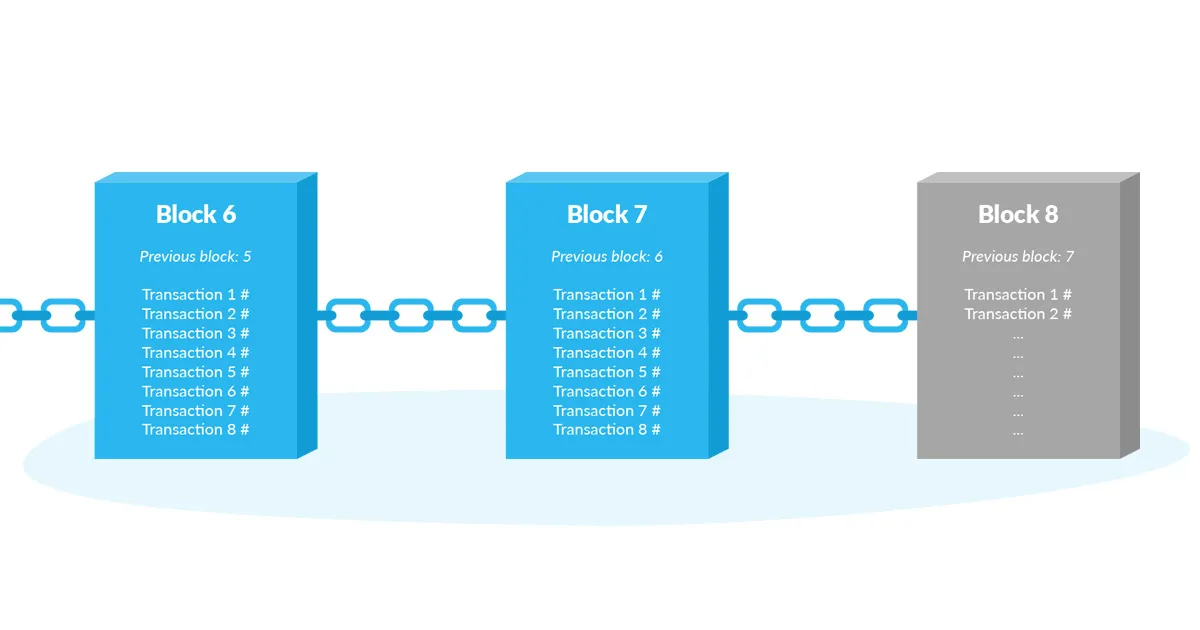
3.2 Blockchains
Strictly speaking, a blockchain is a decentralized, distributed ledger that records transactions across multiple computers in a secure and immutable manner. Once recorded, data on a blockchain cannot be altered without consensus - making it a transparent and tamper-resistant foundation for digital ownership, money, and applications. However, it can be more intuitively understood as a shared, global virtual computer powered by a network of thousands of physical machines.
A blockchain is a decentralized, distributed ledger that records transactions across multiple computers in a secure and immutable manner. Once recorded, data on a blockchain cannot be altered without consensus - making it a transparent and tamper-resistant foundation for digital ownership, money, and applications.
These machines collectively maintain the state of the global virtual computer and control its transition to new states. In the context of blockchains, "state" refers to the current condition or status of the network, including balances, data stored across all accounts, and - on smart contract platforms - the contracts themselves.
To achieve consensus on the correct state and valid state transitions, all the network participants (commonly referred to as "nodes") need to constantly check those transitions using the network’s software. When the majority of nodes agrees to a proposed state, it is immutably recorded as the network’s official state.
Each state within a blockchain is represented by a block, which is essentially a piece of data capturing all actions on the network, such as transfers and interactions with applications. As the term “blockchain” implies, these blocks are linked sequentially, forming a chain that represents the network’s entire transaction history.
To ensure that every node correctly verifies the network’s transactions and consistently behaves honestly, nodes are continually rewarded with the network’s native currency. Conversely, dishonest or malicious behavior results in penalties. This mechanism underpins the operation and security of most blockchains today. This short five-minute video provides a straightforward explanation of how a blockchain works.
Due to the inherently open nature of the blockchain network, developers can build and publish their applications without needing permission, making them accessible to anyone globally at any time.
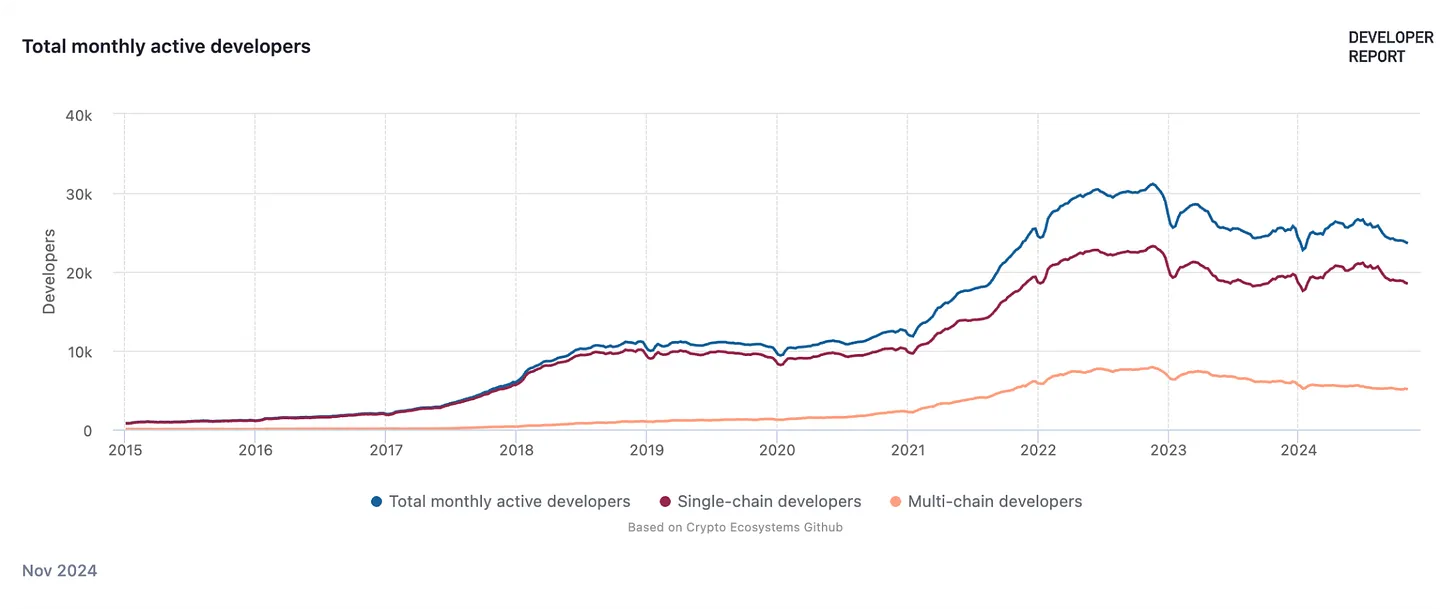
This transparency ensures that every action on a blockchain network can be traced by anyone, making blockchains unsuitable for conducting illegal activities. Nonetheless, a common misconception persists that this technology is primarily used by criminals for such purposes. According to analytics firm Chainalysis, only 0.34% of total onchain transaction volume in 2023 was linked to illicit activities.
Another major advantage of blockchains is their robustness. Unlike traditional web infrastructure, where data is processed and stored on centralized servers - making it more susceptible to attacks by malicious actors - blockchains eliminate the risk of a 'single point of failure'. As outlined earlier, each node maintains a complete copy of the network’s historical data, greatly enhancing security and resilience.
To conclude, the main strengths of blockchain networks are as follows:
- Blockchains are democratic:
Blockchain networks are open and accessible to anyone - developers and users alike - ensuring equal opportunity for participation. Moreover, the network treats all code and data equally. As long as participants adhere to the network’s rules, their transactions will be processed by the nodes. - Blockchains are transparent:
Anyone can review a blockchain's history and be confident that a legitimate process created the system’s current state. Even if one does not personally audit the code or data, they can trust that others have done so, fostering greater confidence in the system. - Blockchains can make strong commitments about their future behavior:
This is because, in blockchain networks, the software ultimately sets the rules and controls the network. Unlike traditional computer networks, where control lies with the hardware ownership and human oversight, blockchains are governed primarily by their underlying code. This means that any code executed on a blockchain will continue to operate as designed, ensuring consistent and predictable behavior. Traditional computer networks can’t make such commitments, as their operation can be altered by those who control the hardware and servers.

Since the launch of Ethereum and other smart contract platforms in the mid-to-late 2010s, the principles and features of blockchain networks driving the crypto and Web3 movements have gained significant attention. Along with this interest has come a substantial influx of capital, developers, and users.
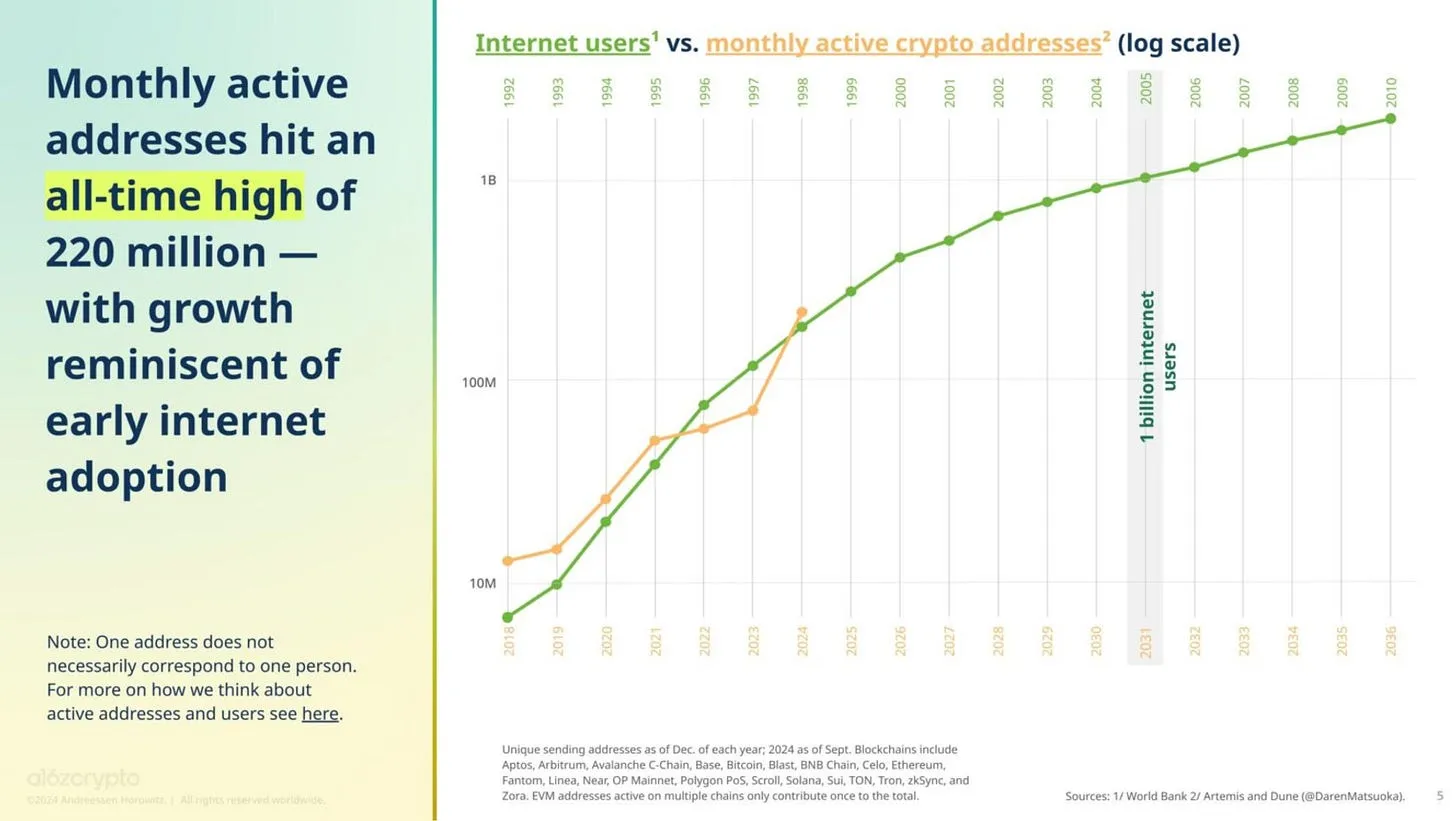
Since 2014, total investment in the blockchain sector has surpassed $100 billion, with the majority occurring since 2018.
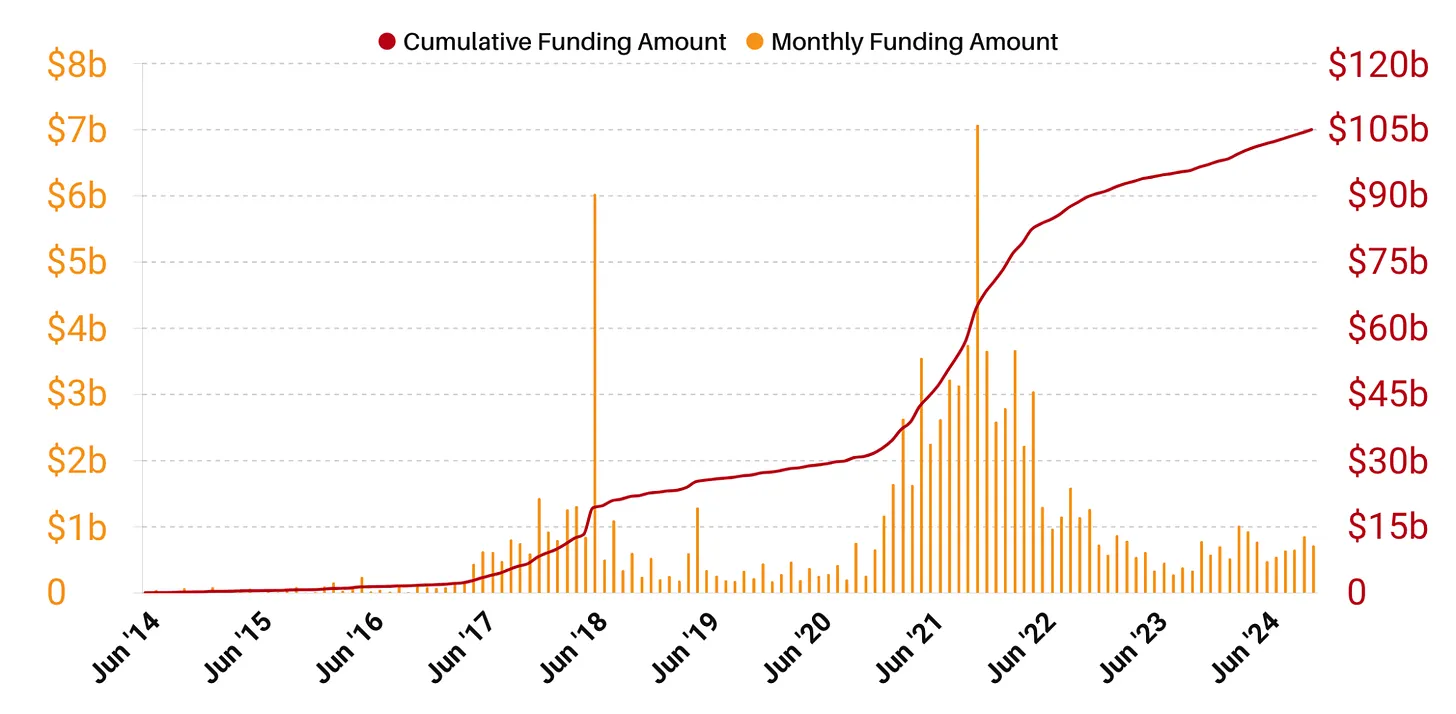
4. Web3’s Disruptive Potential
Blockchain technology has reached a stage of maturity that allows it to deliver meaningful, real-world value - far beyond the speculative hype of earlier years. While adoption in Western markets has been gradual due to established financial infrastructure and payment systems, its potential to transform efficiency, transparency, and ownership is becoming increasingly clear - especially in sectors such as finance, payments, infrastructure, and identity.
In contrast, emerging markets have showcased blockchain’s value as a safeguard against inflation, corruption, and exclusion from traditional banking. These regions have proven that blockchain-based tools can address structural shortcomings where legacy systems fail - offering early validation of the technology’s global relevance.
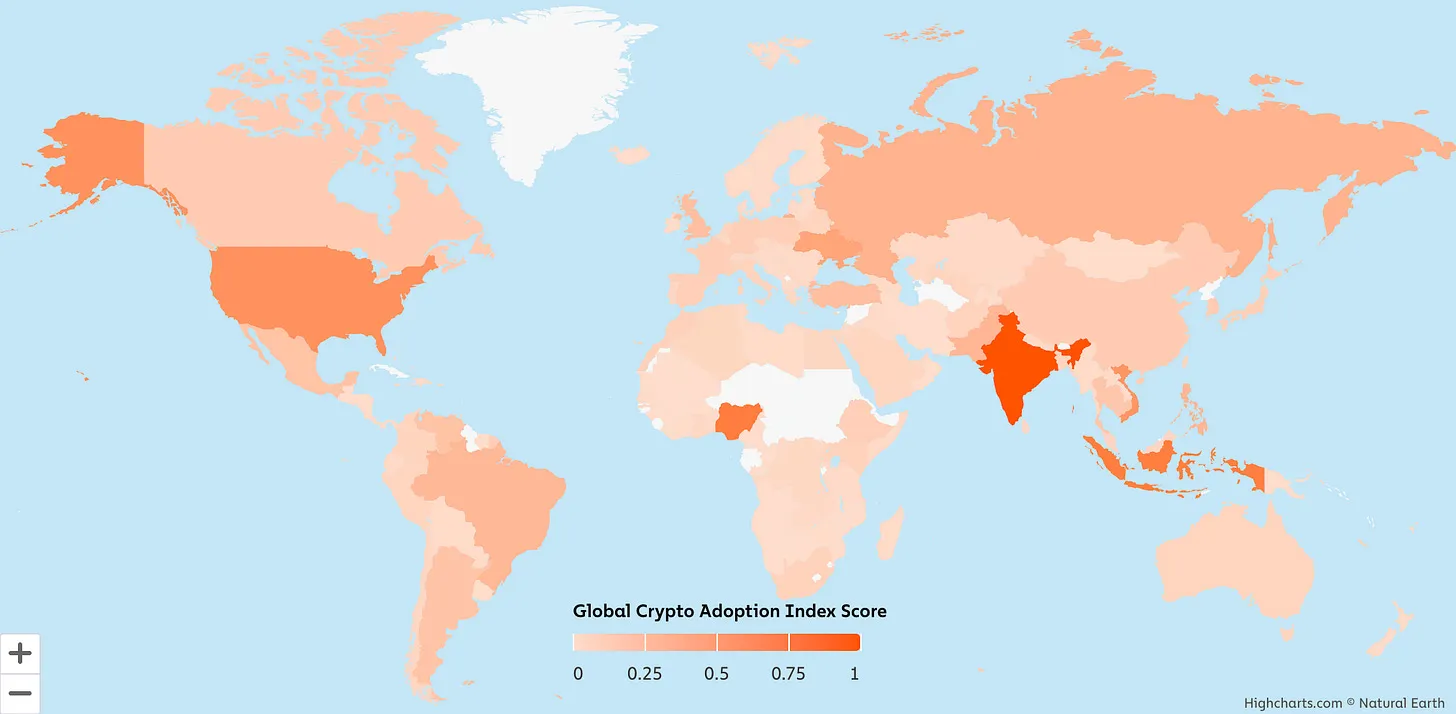
As developer ecosystems expanded, the evolution of blockchain networks made it possible to launch more powerful and user-friendly applications. These new systems leverage cryptoeconomic incentives, reduce reliance on intermediaries, simplify the complexity of blockchain technology, and deliver functionality that was previously unfeasible. As a result, Web3 is now laying the groundwork for disruptive innovation across multiple verticals, thereby delivering real value to users worldwide.
The following sections explore some of the verticals where blockchain-based applications are already challenging traditional players.
4.1 Finance
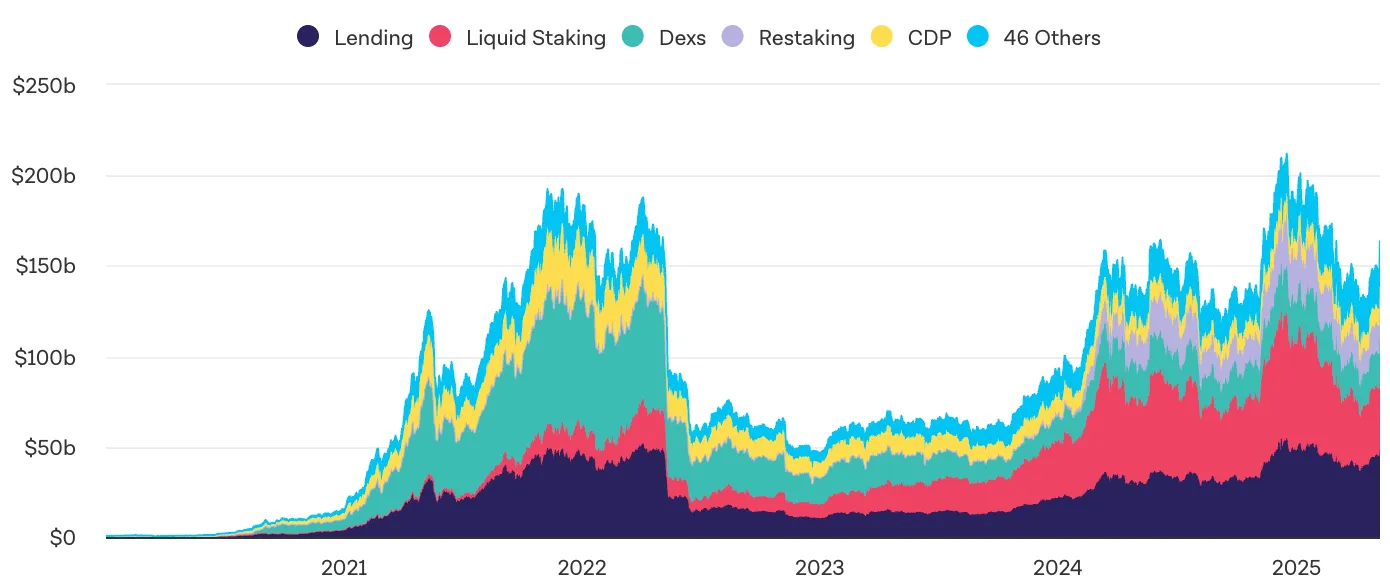
As of now, approximately $164 billion is deployed in DeFi (Decentralized Finance) applications. The revolution behind DeFi is simple: it enables anyone to access financial applications that replicate the functionality of various financial products previously restricted to a select group of individuals.
Decentralized exchanges (DEXes) represent a significant segment of DeFi infrastructure, enabling permissionless trading of digital assets. These protocols operate without intermediaries, allowing direct peer-to-peer transactions. Uniswap, the leading DEX platform, has facilitated over $2 trillion in trading volume since its 2018 launch, demonstrating the scale and adoption of decentralized trading infrastructure.
Lending protocols represent another fundamental component of DeFi. These platforms enable users to obtain loans against their cryptocurrency holdings without intermediaries, relying on automated smart contracts. Aave, the leading lending protocol, currently has ~$26 billion in total value locked (TVL).
Tokenization
Since early last year, tokenization has emerged as a significant trend within the DeFi ecosystem. While the concept of converting real-world assets, such as treasury bills or corporate bonds, into digital tokens on blockchain networks had been explored extensively in the past, recent macroeconomic conditions and endorsements from financial leaders like BlackRock CEO Larry Fink - who described tokenization as "the next generation of financial markets" - have reignited interest in the sector. In particular, the tokenization of U.S. treasury bills has experienced remarkable growth.
Tokenization means putting real-world assets – like bonds, treasuries, or real estate – on-chain. That makes them programmable, transferable, and composable. It removes friction. It automates processes. And it opens access.
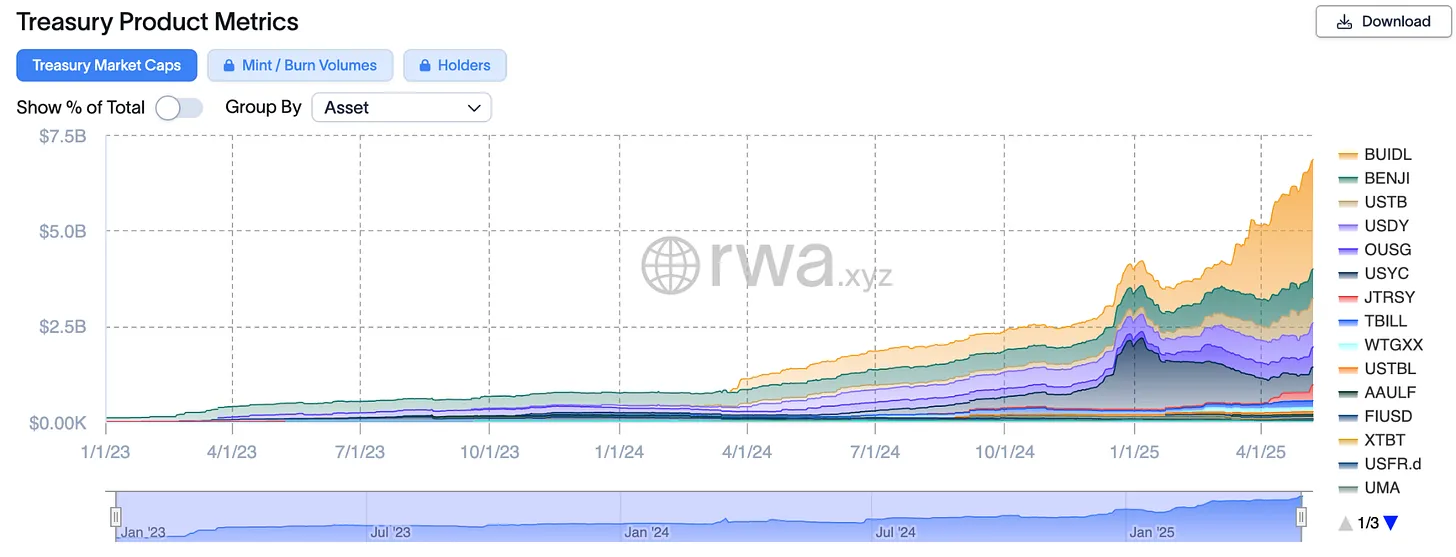
A recent example is BlackRock's tokenized money market fund, BUIDL. Since its launch at the end of March, BUIDL has attracted over $2.86 billion, making it the second largest product of its kind.
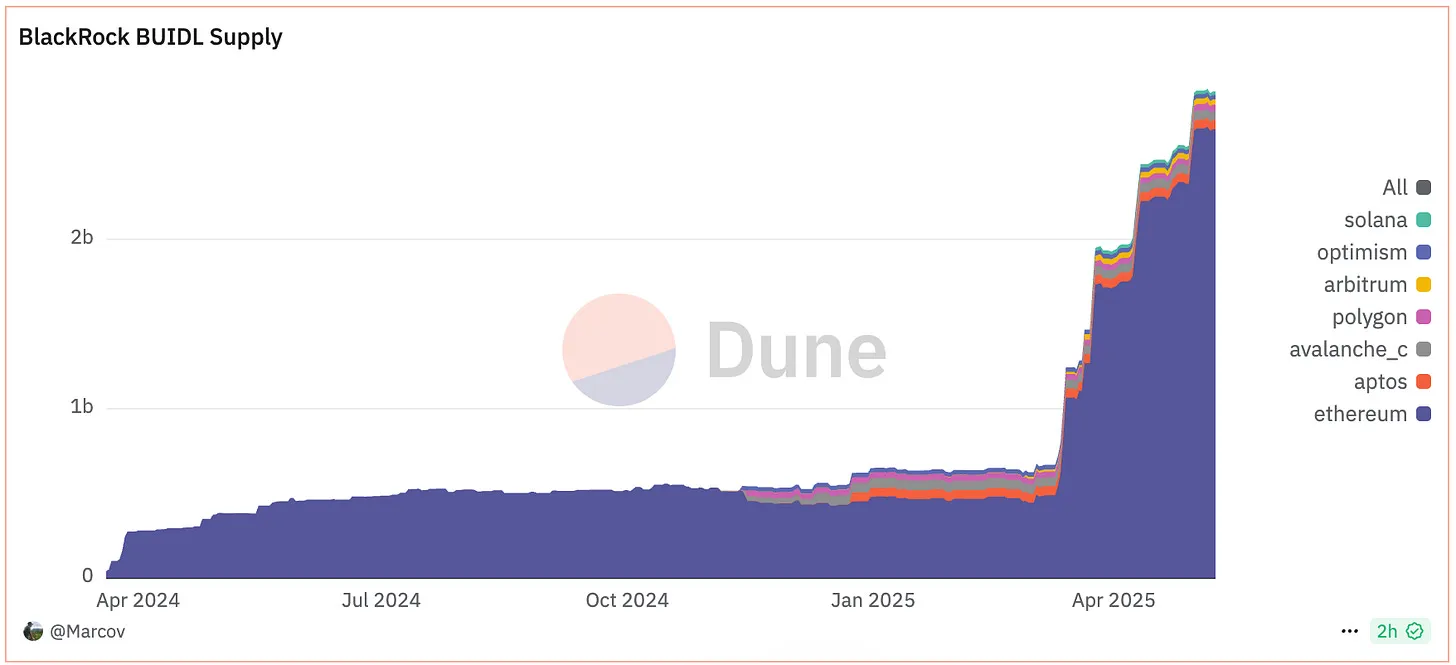
A notable player in the rapidly growing tokenized treasuries market is the French startup Spiko, a portfolio company of Blockwall. Since launch, the platform has attracted $115 million in U.S. treasury investments and €236 million in European bond allocations. With a 3.28% market share in tokenized T-bills, Spiko has established a strong foothold in this emerging market.

The success of such products lays the foundation for a substantial transformation in the digital assets markets, encouraging additional funds to follow suit and further accelerate the tokenization of the world's assets.
Benefits of Tokenization (for Traditional Financial Institutions)
Moreover, many financial institutions initiated various proof-of-concept projects using tokenization to enhance their internal processes. In doing so, they discovered that tokenization enables increased capital efficiency and cost savings, with figures ranging from 20% to 65% depending on the processes.
Traditional transactions often require up to two days for processing, leaving capital idle and reducing efficiency. In contrast, blockchain transactions settle within seconds, operate around the clock, and carry lower counterparty risk. This dramatically improves capital efficiency across major financial operations. Furthermore, cost savings are achieved by significantly reducing the reliance on intermediaries in these transactions.
Tokenization also enables fractional ownership of assets. This allows multiple investors to collectively hold shares in assets that were previously inaccessible for shared ownership.
One notable instance of tokenization is Picasso’s 'Fillette au béret,' which was tokenized in 2021 by the Swiss digital asset bank Sygnum.
As a result, multiple investors were able to acquire fractional shares in the artwork, collectively sharing ownership. Last year, the token holders participated in a vote to decide on accepting an offer for the sale of the artwork.
By facilitating broader participation, tokenization democratizes investment opportunities, opening up traditionally exclusive markets, such as fine art, to a wider range of investors.
Leading management consulting firms such as McKinsey & Company, Roland Berger, and Boston Consulting Group forecast that tokenization is poised to evolve into a $10 trillion market by 2030.

Prediction Markets
Prediction markets represent another area experiencing significant attention and adoption.
Polymarket currently leads this space, enabling users to speculate on diverse events from geopolitical elections and pop culture trends to the medal tally at the Olympics using stablecoins. This platform exemplifies the broader potential of prediction markets, which aggregate collective intelligence to forecast real-world outcomes with financial stakes.
Polymarket was launched in 2020 and experienced explosive growth in 2024: It now boasts over 290,000 monthly active users and reached $2.5 billion in trading volume in November 2024 alone, underscoring its dominance as the largest prediction market today.
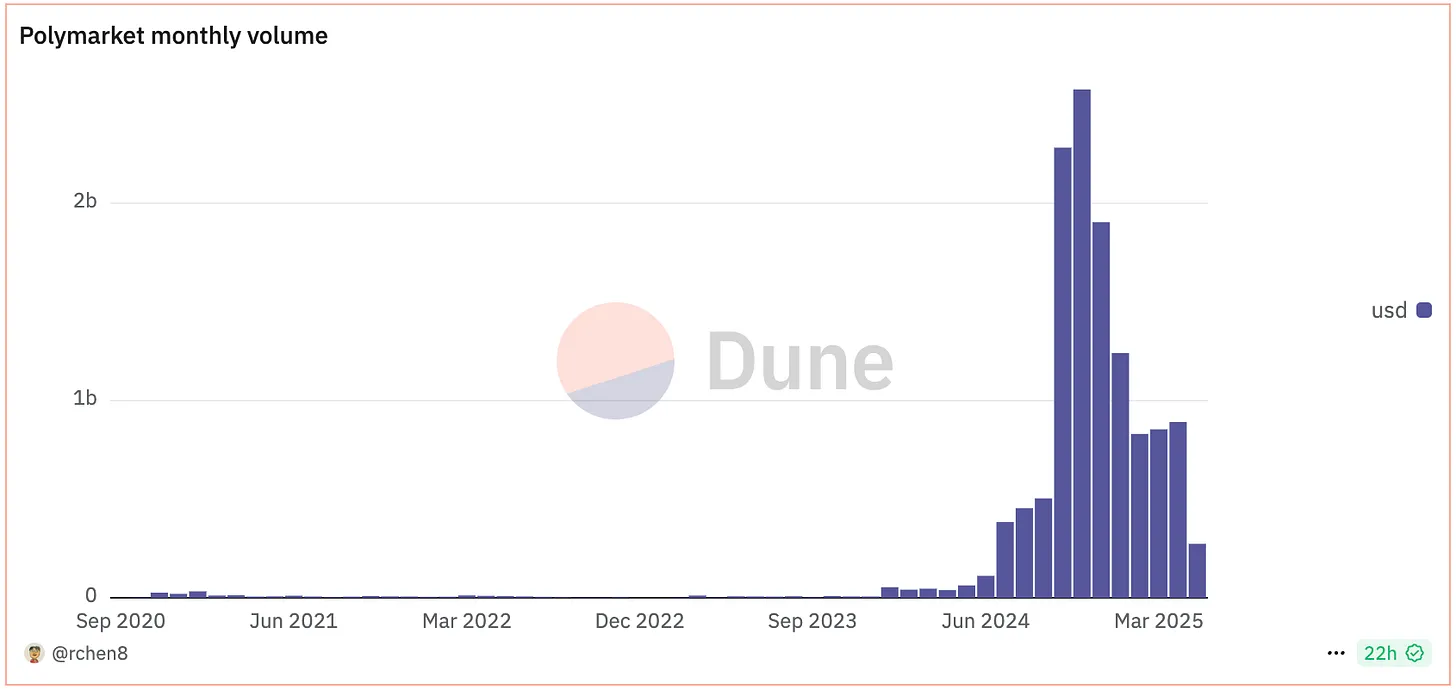
To put these figures in perspective: During Q1 2024, the platform averaged a monthly volume of approximately $50 million USD, with active user numbers ranging from 2,000 to 4,000 per month.
This years growth was driven primarily by the prediction markets related to the U.S. presidential elections, which accounted for a majority of the platform's total trading volume this year.
With increasing volumes, Polymarket's media relevance has also risen. Its ability to capture real-time political sentiment, often more accurately than traditional polls, is leading more mainstream media outlets to use its data for reporting.
Among them are CNN, The Wall Street Journal, and Bloomberg, which has even integrated Polymarket's election data into the Bloomberg Terminal.
Furthermore, the platform accurately predicted Donald Trump's victory and, due to its ability to rapidly incorporate new information, became a preferred source for tracking swing state vote counts for many observers - including Donald Trump and his team.
As with many financial use cases, blockchains are an ideal infrastructure for prediction markets, enabling the efficient, low-cost, and rapid transfer of capital across borders.
4.2 Payments & Stablecoins
Stablecoins and blockchain-powered payment solutions are increasingly seen as one of the most impactful innovations in the cryptocurrency space, often cited as its flagship real-world application.
Stablecoins are blockchain-based tokens that are typically pegged to fiat currencies – like the US Dollar or Euro. They combine the stability of traditional money with the programmability of digital assets.
The two most widely used stablecoins are USDT (Tether) and USDC (USD Coin). In 2024, stablecoins processed over $27 trillion in transaction volume, and the total market capitalization of all stablecoins reached $238 billion. That’s more than Visa and Mastercard in terms of volume in 2024.
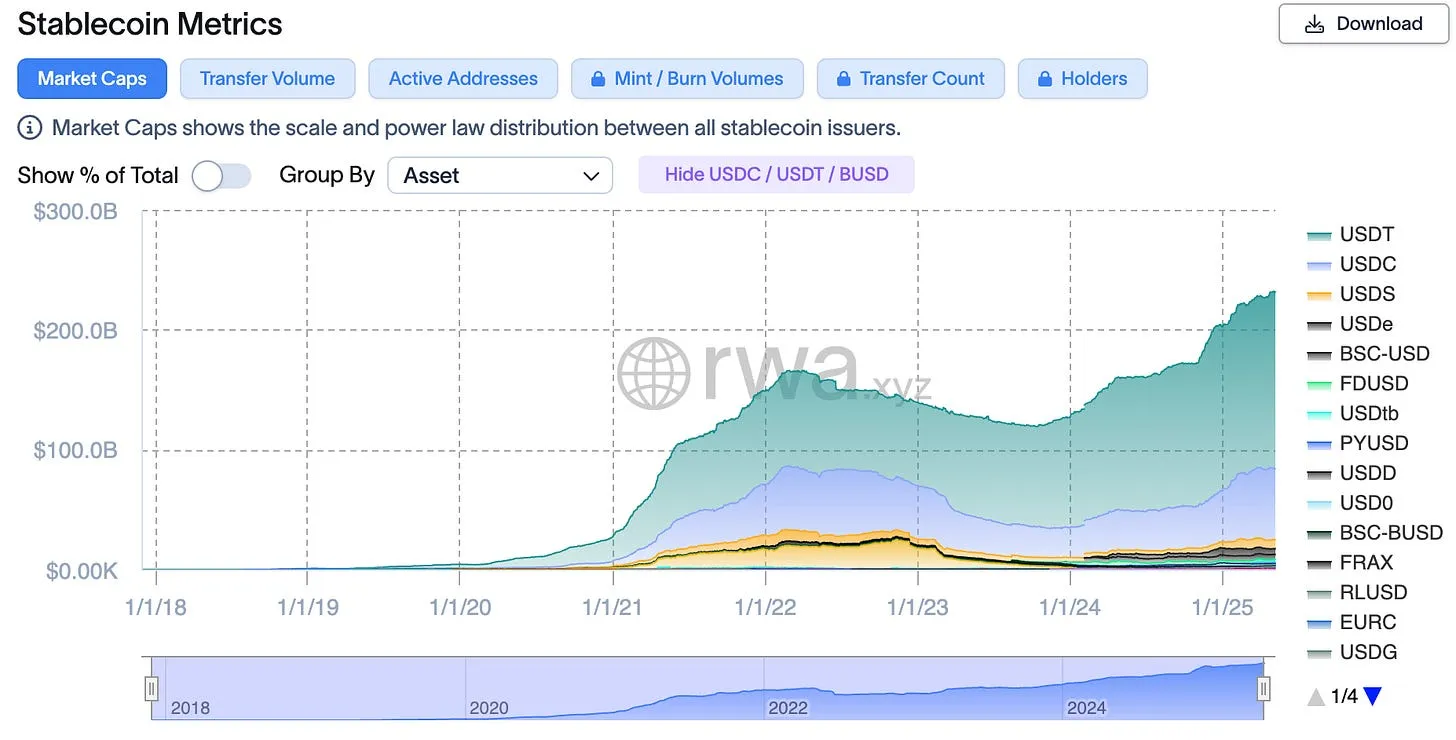
Many people globally are using these dollar-pegged tokens to get access to the U.S. dollar - oftentimes in order to preserve their buying power and flee their depreciating national currencies (e.g. in Argentina or Turkey).
That said, the most common use for stablecoins is in cross-border payments, especially remittances. This is because stablecoins can cut transaction costs by as much as 80% compared to traditional payment systems. As a result, major players like Visa, Mastercard, Stripe, and PayPal are integrating crypto-payment infrastructure or launching their own stablecoin solutions.
Another great example of how this technology is applied today is Nilos, one of Blockwall’s portfolio companies, which is offering a Web3-native payment platform that reimagines how businesses move money globally.
Imagine a company based in Europe that needs to pay freelancers in Argentina, suppliers in India, and contractors in Kenya – in different currencies, across different banking systems, with different regulations. With traditional infrastructure, that means delays, high fees, and fragmented liquidity.
Nilos makes that seamless. Through their blockchain-based platform, businesses can send payments across 100+ countries, hold balances in multiple currencies, and convert FX in real-time – all from a single interface.
What’s unique: Nilos is fully licensed in the EU and Canada. It integrates both crypto and fiat payment rails, enabling compliant settlement on either side of the financial system.
They’re not replacing banks – they’re complementing them, bridging the gap between today's finance and tomorrow’s programmable money.
It’s these kinds of platforms that show Web3 isn’t just an idea. It’s infrastructure – ready to be used, today.
Yet, cost savings are not the only factor drawing established and emerging players into the stablecoin market.
Stablecoin Issuers’ Business Model
Stablecoin issuers arguably operate one of the most lucrative business models in the financial landscape today.
They accept fiat deposits from users and primarily invest these funds in short-term U.S. Treasury bills. The interest accrued from these investments is typically retained by the issuers, rather than being distributed to the stablecoin holders. For example, Tether, the issuer of USDT, the largest U.S. dollar-pegged stablecoin, generated over $1 billion in profits during the first quarter of 2024 by holding more than $90 billion in T-bills.
This figure is especially remarkable given that the company reportedly operates with a team of just around 100 employees.
Let’s compare the old to the new:
- Transaction fees: Remittances traditionally averaged around 6.4% – but in exotic corridors like Europe–Africa or Latin America–Europe, fees for remittances can reach 15–18%; with stablecoins, they drop to just a few cents
- Transaction times: From days to minutes
- Global payroll: Automated and instant
- Financial inclusion: No bank account needed – just a smartphone
- Inflation hedge: Stablecoins give people access to stable currencies, such as Dollar or Euro, in fragile economies
- Not issued or controlled by central banks: unlike CBDCs such as the digital Euro, stablecoins are issued by private entities and operate outside direct monetary policy controls – though their backing assets may still be influenced indirectly
Central Bank Digital Currencies (CBDC)
But stablecoins aren’t the only form of digital money today. As of mid-2024, over 130 countries are actively exploring the development of Central Bank Digital Currencies (CBDCs) at various stages, from research and development to pilot programs and even full implementations.
While a few countries, such as the Bahamas with its "Sand Dollar" and Nigeria, have fully launched CBDCs, many others are still testing and refining their approaches.
Countries such as Sweden, China, and several others are in advanced stages of piloting their CBDCs. Blockchain technology is being explored as the underlying infrastructure for some of these initiatives due to its transparency and security.
However, not all countries are adopting blockchain. Some are using more traditional digital infrastructures, depending on their regulatory and technical requirements.
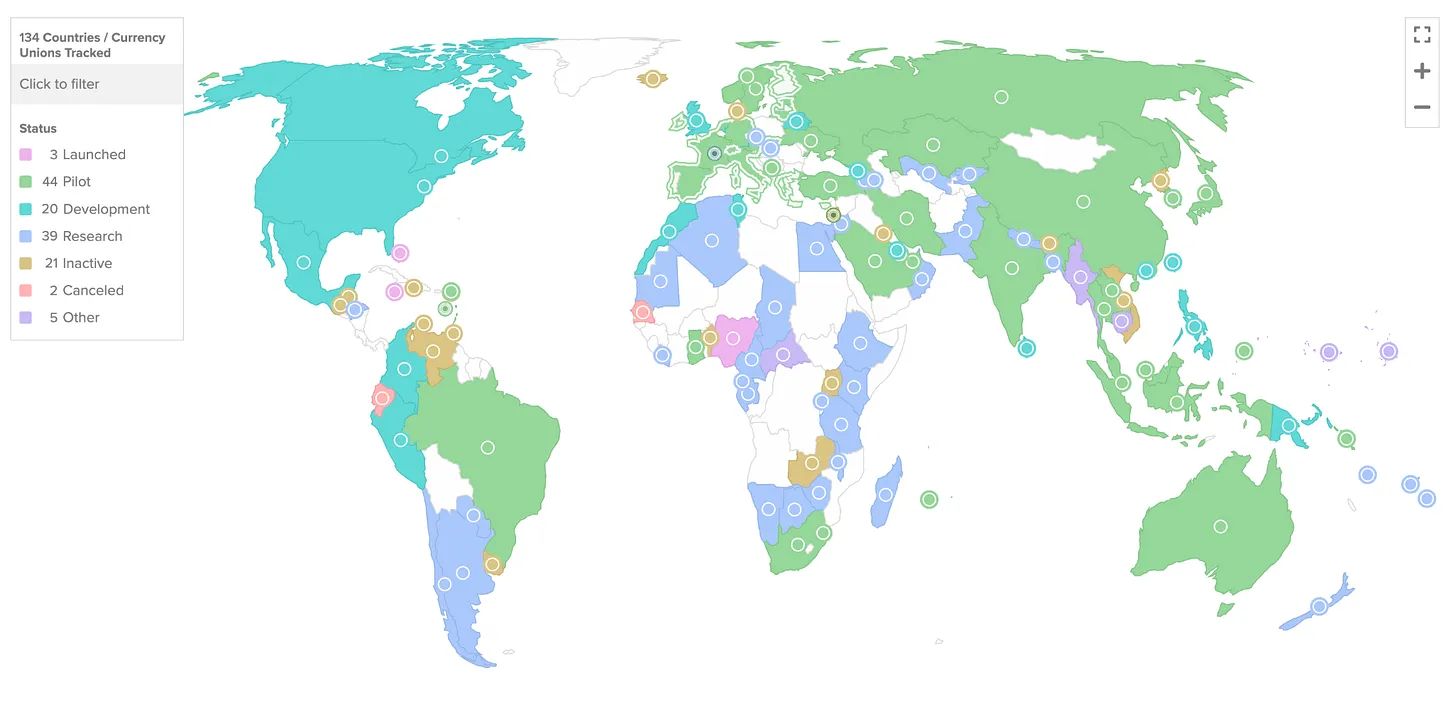
4.3 Physical Infrastructure Networks
Decentralized Physical Infrastructure Networks (DePIN) represent one of the most rapidly expanding segments within the blockchain industry. These networks revolutionize many industries and change the way physical infrastructure is built by offering token rewards to participants who help expand the system.
Traditionally, building physical infrastructure, such as telecommunications networks, required decades of effort and significant resources from major providers. In contrast, DePIN networks like Helium leverage crowdsourcing to achieve rapid and cost-efficient network expansion.
The success of this model hinges on tokenized incentive structures. Rather than compensating participants in USD or Bitcoin - both of which would be prohibitively expensive - companies instead distribute their own tokens.
This approach allows them to finely tune the token’s issuance and distribution while ensuring it captures the value generated by the network’s usage and growth. By aligning the token’s value with network expansion, early participants benefit directly from the token's appreciation. This creates a 'positive flywheel' effect, where more participants are drawn to the network, accelerating growth even further.
Helium and Hivemapper are prime examples of how this incentive model has proven its effectiveness, driving rapid infrastructure build-out in record time.
Helium: The People’s Network
Helium is one of the most prominent DePIN networks to date.
Via Helium Mobile the company develops a decentralized network that incentivizes users to create mobile communication infrastructure for 5G coverage.
Users acquire Helium Hotspots (mini cell towers) and install them at their homes, providing 5G connectivity to Helium Mobile subscribers in their area. In return, they receive token rewards, significantly reducing the traditional costs of building a mobile network.
As described above, setting up legacy telecommunication infrastructure is a highly time-consuming and costly process, often requiring vast capital and long approval times to deploy traditional cell towers across a country. In contrast, Helium's crowd-sourced model expedites this process and drastically reduces costs.
By leveraging this more efficient system, Helium Mobile offers some of the cheapest unlimited data plans in the U.S. While still expanding, the network partners with T-Mobile to ensure nationwide coverage in areas where Helium's network remains sparse. This partnership allows Helium Mobile to deliver services in places where its own network has yet to reach full capacity.
Meanwhile, the company recently launched its "Carrier Offload Beta," allowing other mobile carriers to redirect part of their traffic to the Helium network during times of congestion or in areas where their infrastructure is underdeveloped. Since the program's launch in June, nearly one million users from other carriers have connected to the network, offloading 33 TB of data daily, equivalent to approximately 15,000 hours of video content.
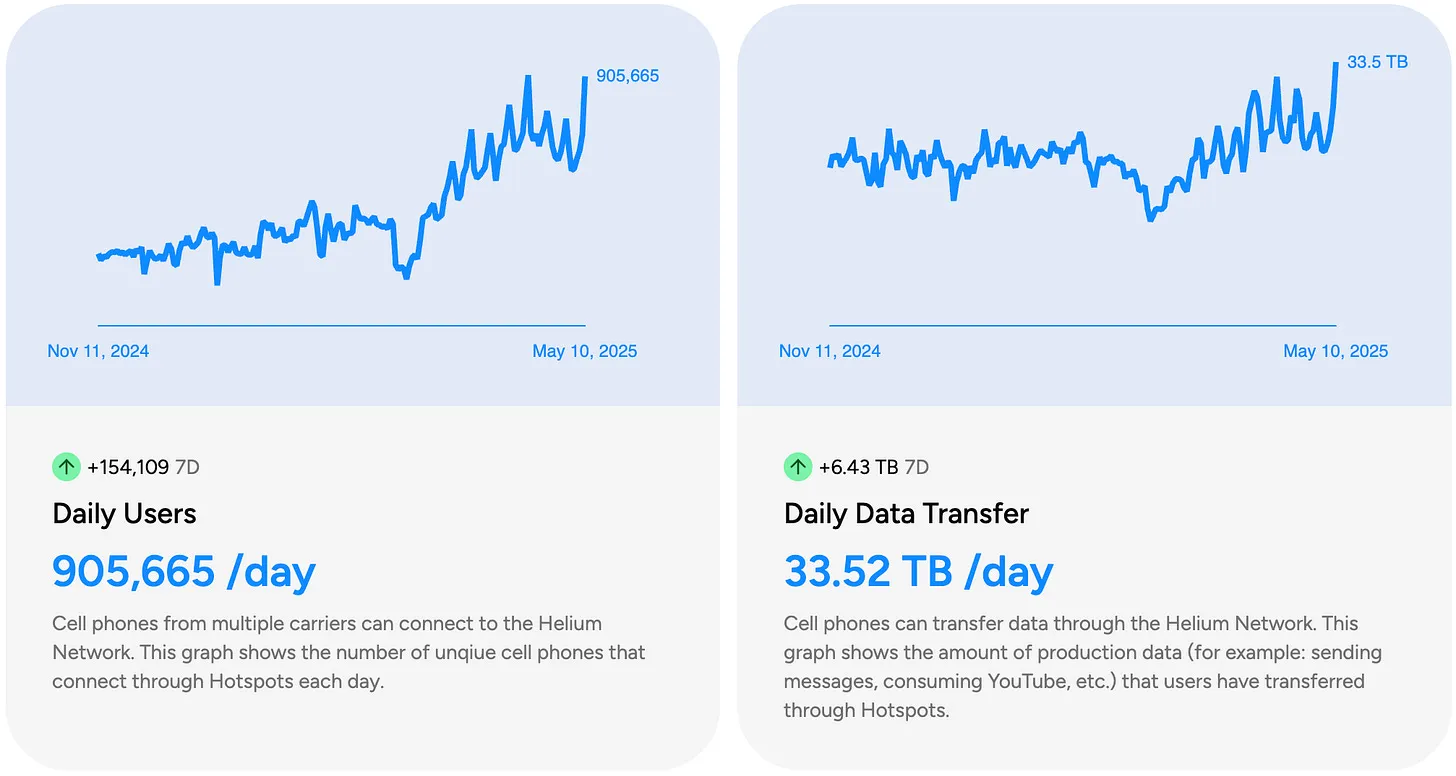
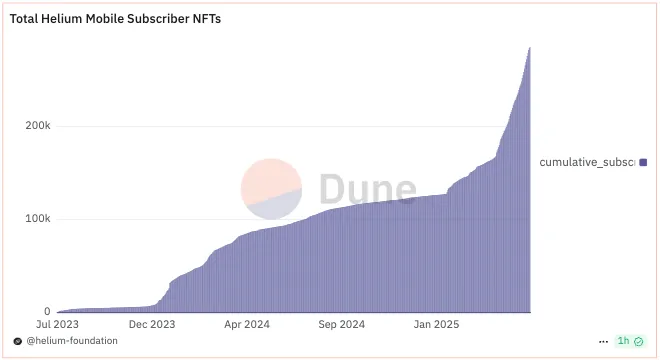
Hivemapper
Another well established DePIN project is Hivemapper. The company is building a decentralized mapping network, where users contribute mapping data via dashcams and are rewarded with the platform’s native token.
Hivemapper monetizes this data by offering it to businesses and organizations that require high-quality, up-to-date geographic information, such as logistics companies, ride-hailing services, and other industries relying on mapping data. Compared to Google Maps, Hivemapper's approach allows it to provide more accurate data and significantly accelerates the mapping process.
Since Hivemapper’s launch two years ago, the company has recorded more than 19.42 million unique road kilometers, representing approximately 32% of the world's total road kilometers. In comparison, Google Maps took five years to capture just 10% of the world’s road network, underscoring the rapid execution and scalability advantages that decentralized networks like Hivemapper can offer.
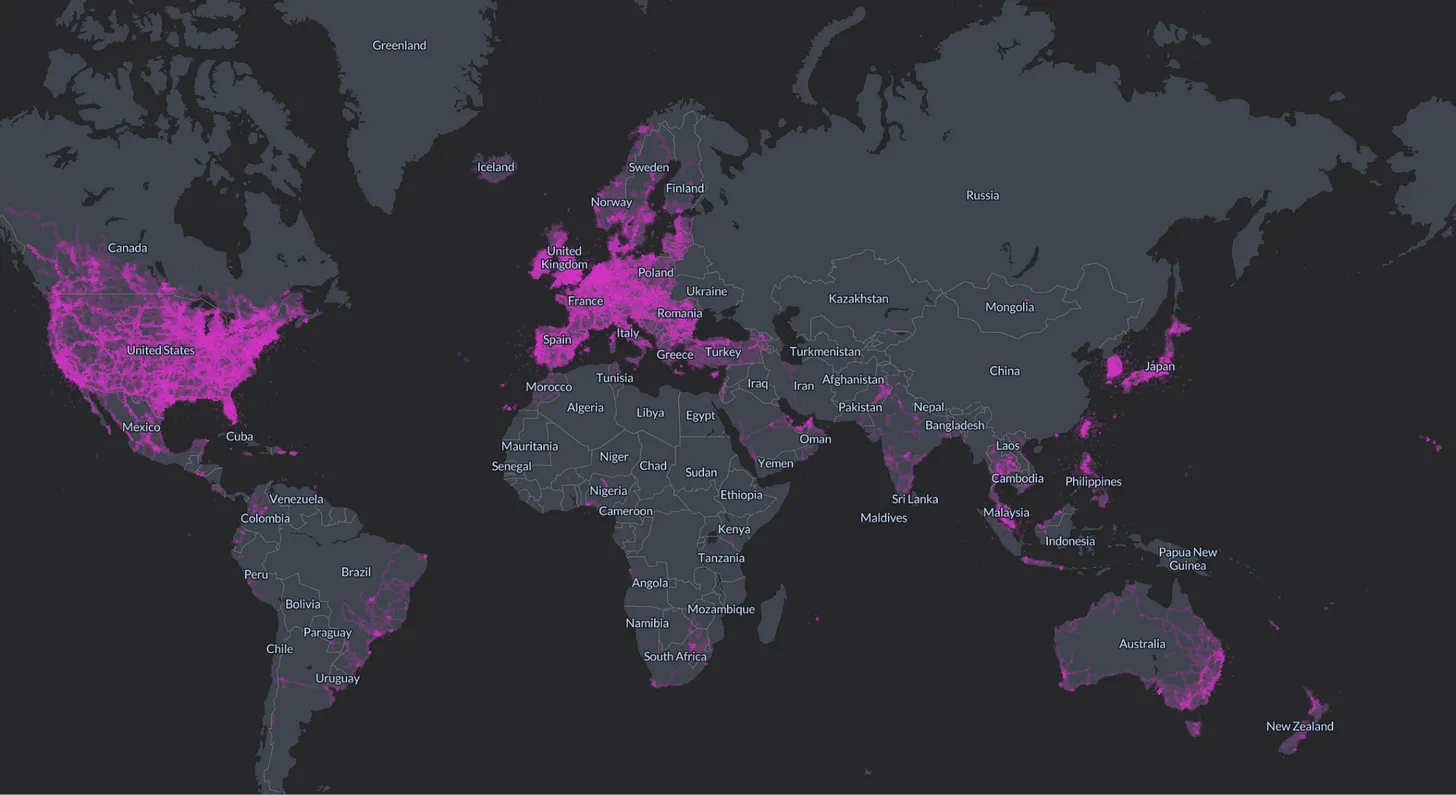
4.4 Social
Crypto’s inherent programmability and composability make it a uniquely social technology. Social applications are emerging as a dynamic category, leveraging blockchain’s properties to reimagine community interaction and creator economies. Some platforms focus on financialization, enabling content creators to monetize their influence in novel ways. Others aim to leverage the composability of blockchain-based applications, providing developers with the opportunity to create entirely new types of social experiences.
Currently, the Farcaster protocol has gained the most traction in this area. Farcaster is a decentralized social network where users' social graphs and content are stored onchain, allowing developers to build various applications on top of it. This structure enables users to truly own their data, giving them the freedom to opt in and out of applications at any time while retaining their followers and content.
This approach contrasts sharply with the Web2 status quo, where users repeatedly spread their personal information across the servers of centralized companies, effectively relinquishing control over their data each time. In contrast, blockchains allow for the creation of protocols that store user data in one centralized place.
To illustrate, imagine a platform like X or LinkedIn operating on a decentralized protocol. If the algorithm or advertisements became undesirable, users could seamlessly switch to an alternative platform without losing their social graph or history. This represents a significant shift from today's centralized models, offering users greater flexibility and control.
Additionally, the integration of blockchain-based microtransactions into social platforms offers creators and artists new ways of monetization, including paid subscriptions and exclusive content access. Since user wallets are directly integrated with the platform, payment processes become significantly smoother, creating a more cost-efficient and user-friendly experience for both content creators and their audiences.
Going forward, decentralized social networks could also allow users to control the sharing of their personal data, giving them the option to share for more personalized ads or retain complete privacy while maintaining their social connections and content across platforms.
4.5 Digital Ownership
NFTs are foundational to establishing verifiable ownership and authenticity in the digital realm. By encoding unique, immutable proof of ownership on the blockchain, they enable individuals and communities to securely manage digital and physical assets - from art and music to real estate and intellectual property. This fosters a stronger sense of value and belonging within communities, allowing individuals to truly "own" their digital achievements or contributions.
Moreover, NFTs open up new monetization opportunities. Creators and brands can directly monetize their digital assets, earning revenue through initial sales and receiving ongoing royalties whenever the NFT is resold, thanks to the programmable nature of blockchain. This not only incentivizes quality content creation but also ensures a steady income stream for creators.
One company leveraging this technology is the French startup Zealy, a Blockwall portfolio company. Through their gamified engagement platform, Zealy fosters a more direct relationship between brands, content creators, and their fans, significantly enhancing engagement and loyalty.
Established brands like Michelin and FIAT have successfully used Zealy's platform, rewarding loyal users with NFTs and creating deeper emotional connections that drive lasting loyalty. For example, Michelin introduced the ‘Michelin Club’ on Zealy, engaging members through quests related to motorsports, gastronomy, and travel, resulting in over 100,000 completed quests and rewarding participants with NFT collectibles. Similarly, FIAT built a dynamic fan community with Zealy, attracting over 35,000 members who completed 530,000 quests, with exclusive rewards such as access to limited edition vehicles.
This comprehensive use of NFTs illustrates how digital ownership not only transforms engagement but also provides sustainable financial opportunities for brands, creators, and communities alike.
4.6 Privacy
Cryptography is the backbone of the blockchain space, as it eliminates many of the trust assumptions inherent to traditional systems and conventional digital environments.
As the crypto and Web3 sectors grew and attracted significant capital, more attention and funding flowed into cryptographic research, leading to breakthroughs once considered distant possibilities.
Let’s examine three of the most influential technologies poised to redefine our future online and blockchain interactions, with a focus on advancing privacy:
Zero-Knowledge-Proofs (ZKPs)
ZKPs allow one party to prove the validity of information to another without revealing the actual data. Simply put, it's like proving you know a password without sharing it. You can find an easy-to-understand explanation of ZKPs here.
In crypto, ZKPs are used by privacy-focused blockchains like Zcash to validate transactions without exposing details. Layer 2 scaling solutions like ZKSync leverage ZKPs to scale the Ethereum network efficiently.
In the future, ZKPs could enable private identity verification, allowing users to confirm they are over 18 without revealing their date of birth (see here for a quick demo). Additional use cases include secure voting systems and confidential blockchain transactions.
Fully Homomorphic Encryption (FHE)
FHE allows data to be processed and analyzed in its encrypted form, meaning you can perform calculations on encrypted data without decrypting it. This ensures privacy and security. While still in the early stages, FHE could revolutionize how sensitive data, such as financial records or health information, is handled in blockchain applications, making it possible to conduct complex computations without exposing the data.
Fully Homomorphic Encryption (FHE) is increasingly being tested in practical scenarios.
For instance, IBM is working on integrating FHE into cloud services, allowing companies to analyze customer data securely without ever decrypting it, ensuring data privacy even in cloud environments.
Another example is in the healthcare sector, where FHE enables researchers to perform large-scale analytics on encrypted patient data, facilitating medical research without exposing sensitive personal information.
These cases illustrate how FHE can maintain privacy while allowing valuable insights to be drawn from encrypted datasets. In the context of crypto and Web3, there are some projects building out protocols or even whole blockchains that allow to develop FHE-based applications.
Multi-Party-Computation (MPC)
Multi-Party Computation (MPC) allows multiple parties to collaborate on a calculation without revealing their individual data inputs. Think of it like calculating the average salary of a group without anyone sharing their specific salary.
A concrete example in crypto is MPC's use in wallet management, like ZenGo's wallet, which ensures private key security by splitting it into multiple shares.
Another example is the infrastructure provider Fireblocks, which uses MPC to enable secure and seamless transactions for institutional investors by ensuring that no single party holds the entire key, enhancing security for digital asset transfers.
As this technology evolves, it will further enhance privacy and security across decentralized finance (DeFi) and digital asset management.
If you want to dive deeper into the different privacy enhancing technologies, feel free to take a look at the dedicated blog post by our Principal Syed Armani.
4.7 Gaming
The gaming industry has emerged as one of the most lucrative and rapidly expanding sectors in the entertainment world, with a global revenue of around $475 billion in 2024. Nearly every successful game today features its own in-game economy, where players spend substantial amounts of money on cosmetic items to customize their characters and gaming experiences. For instance, players of ‘League of Legends’ spent over $1 billion on in-game skins in 2020 alone.
However, these economies currently exist entirely on centralized servers controlled by game developers, meaning that these companies maintain full authority over the digital assets. This results in isolated, closed economies where players have no means of transferring or further utilizing their hard-earned or purchased items across different games.
Digital Ownership
Blockchain technology presents an opportunity to fundamentally alter this dynamic. By basing the games’ economies on decentralized networks, players can truly own their in-game assets.
Additionally, this opens up previously isolated economies, allowing for interoperability between different games. Players would have the ability to trade assets from one game with those from another, resulting in entirely new dynamics and possibilities.
Play-to-Earn
One of the earliest applications of blockchains in gaming is the ‘play-to-earn’ model, where players can earn real-world value through in-game engagement. Instead of playing solely for entertainment, players are rewarded with in-game assets (such as tokens or NFTs) that carry real monetary value outside the game. This model blurs the lines between gaming and earning, enabling players to transform their time and effort into potential income.
Among the most prominent examples of this model are Axie Infinity and STEPN.
Axie Infinity allows players to collect, breed, and battle virtual creatures known as ‘Axies’. In 2021, the game experienced immense popularity, reaching over 2 million monthly active users at its peak.

Fully Onchain Games
Beyond early blockchain games like Axie Infinity, often considered the first generation of onchain games, a new wave of more advanced projects is now in development.
Thanks to recent advancements in blockchain scalability, these upcoming games can be built almost entirely onchain, offering developers the opportunity to craft unique gameplay experiences that extend beyond purely economic aspects, such as the play-to-earn model.
EVE Frontier, an upcoming game developed by the creators of the popular online game EVE Online, exemplifies this shift. The game is designed to live entirely on the blockchain, granting players unprecedented control not only over their in-game assets, but also the game’s development. Players and developers will be able to create their own smart contracts, which allow for customization, trading, and even the creation of in-game currencies, establishing a truly player-driven and dynamic gaming ecosystem.
The future trajectory of onchain gaming and the innovative features it will introduce is yet to be fully defined. However, the inherently open and transparent nature of blockchain-based games is expected to drive these innovations, emerging from the broader developer community. This openness fosters a collaborative environment, enabling developers to experiment and build upon each other’s ideas, which will be crucial for shaping the future of novel gaming experiences and eventually outcompeting those created by centralized gaming studios.
5. Why Now is the Right Time to Invest?
As an investor, you might consider why this moment represents a strategic opportunity to engage and invest in crypto and Web3.
While crypto and Web3 have been in the spotlight for nearly a decade, their transformative potential is only now beginning to materialize in a way that directly impacts users' daily lives.
Alongside major technical advancements that significantly improve the user experience of blockchain-based applications, the approval of Bitcoin spot ETFs in the U.S. in 2024 has affirmed the legitimacy of the entire industry. After many years, crypto is finally being recognized as an asset class of its own.
In addition, the regulatory landscape for crypto and Web3 companies is improving steadily, as many jurisdictions are working on progressive regulatory frameworks to foster the growth of their digital asset and Web3 industries.
On the following pages, we will take a closer look at major developments of recent years, which lay out the case for why now is the perfect opportunity to get involved and invest in the space.
5.1 Scalability
Since the inception of blockchain networks, scalability has been a huge bottleneck hindering the technology’s adoption. While global payment networks like Visa, on average, process around 8,700 transactions per second (TPS) and can scale up to 65,000 transactions if necessary, Bitcoin and Ethereum are only able to handle around 8 and 119 TPS, respectively.
The numbers make it clear that neither network can support even a small fraction of the world's financial activity, let alone the vast amount of activity happening on the internet.
However, in recent years, the infrastructure has significantly matured. Next-generation smart contract platforms like Solana have optimized for scalability, processing around 1,000 transactions per second (with theoretically maximum 65,000 transactions per second) with transaction fees being a fraction of a cent.
Furthermore, plenty of so-called layer 2 networks have been launched on Ethereum since 2022. Layer 2s are separate blockchains that execute transactions on their networks and subsequently post the state changes on Ethereum.
This way, they can achieve way higher scalability than the Ethereum Mainnet without compromising security and decentralization. As of today, all layer 2 solutions combined process around 20 times more transactions per second than Ethereum, with transaction fees being as low as a few cents.

But the progress doesn’t stop there. For the next few years, further scalability unlocks for existing networks like Solana and Ethereum are planned. Furthermore, third generation platforms are likely to emerge, leveraging continuous improvements in both software and hardware.

5.2 Improved User Experience
Similar to the early internet era, where setting up a dial-up modem was required to go online, the user experience (UX) of early crypto is equally cumbersome, with processes that are anything but intuitive.
Initially, users are required to sign each onchain action with their Web3 wallet, adding extra steps and increasing complexity. Furthermore, most wallets are self-custodial by default, meaning users are solely responsible for securing their assets. If access is lost, their funds are irretrievable. While self-custody is a core principle of crypto, many users find this responsibility challenging.
In response, the industry has focused on enhancing Web3 wallet UX. New wallets now abstract the complexities of wallet management, allowing developers to cover transaction fees and offering improved security features like 'Social Recovery', where the user's friends, family members, or designated crypto custodians can help to regain access to lost wallets.
A major player pushing the boundaries at Web3’s UX is the crypto exchange Coinbase. The company launched their 'Smart Wallets' and drastically changed the way users will interact with blockchain-based applications going forward.
This wallet enables users to create wallets and sign transactions with their fingerprint or FaceID. Additionally, the private key is backed up in the cloud, allowing users to recover their wallets if they lose their device.
Another super interesting feature allows users to connect their smart wallets to their Coinbase accounts and use their exchange balance for onchain transactions. With this approach, transferring funds to a separate wallet to interact with Web3 applications is no longer required.
Thanks to such innovations, the next generation of Web3 users won't struggle using onchain applications. Instead, they will benefit from more intuitive, Web2-like onboarding and user flows.
5.3 Institutional Adoption
Apart from technical improvements, the sentiment surrounding crypto and Web3 among investors and regulators has become increasingly favorable.
Under the previous U.S. administration, which maintained a critical stance toward the crypto industry - particularly through the SEC led by Gary Gensler - financial institutions nevertheless began to recognize the potential of blockchain technology and the value of digital assets as an emerging asset class. A key catalyst for institutional adoption remains the approval of Bitcoin spot ETFs in 2024, which attracted significant inflows that surpassed expectations and marked one of the most successful ETF launches to date.
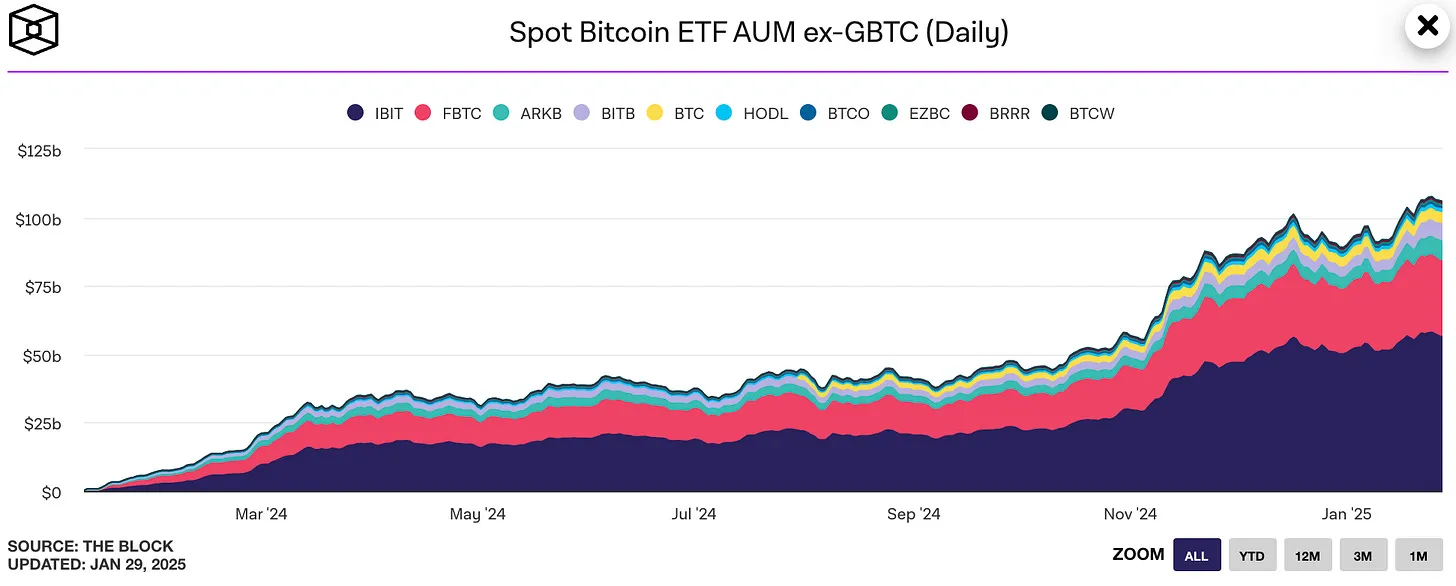
This milestone took the industry ten years to achieve, affirmed that Bitcoin and crypto more broadly are legitimate asset classes, and increased the interest of major financial players worldwide in crypto and Web3.
This legitimization reflects the maturity of a space that has historically only been associated with speculation. Moreover, the growing engagement of these institutions fosters the development of more rigorous auditing processes and compliance frameworks. Their interest and initiatives are also likely to play a pivotal role in driving more regulatory clarity around digital assets.
5.4 Regulation
On the regulatory front, many jurisdictions started to develop extensive regulatory frameworks that should provide crypto and Web3 companies with the necessary regulatory clarity to develop their products and tokens.
In Europe, the Markets in Crypto-Assets Regulation (MiCA) provides a unified framework for all EU member states, with certain provisions coming into force in June of this year.
Similarly, the U.S. has made significant progress in crypto policy. The current administration, under President Trump, has adopted a pro-crypto stance, exemplified by an executive order establishing a cryptocurrency working group to draft new digital asset regulations and explore a strategic national reserve for cryptocurrencies. These efforts, along with recent leadership changes in key regulatory roles, demonstrate a strong commitment to fostering innovation and advancing the digital assets sector.
After years of 'regulation by enforcement', where the SEC targeted some of the most compliant crypto companies with numerous questionable lawsuits while ignoring the truly malicious actors, lawmakers from both political parties are now pushing for clear rules on how crypto companies can operate in the U.S.
These political tailwinds had built up pressure on the SEC. Despite low initial probabilities assigned by ETF experts and the broader markets, the SEC approved the launch of Ethereum's Ether spot ETFs in July 2024. Subsequently, following the inauguration of President Donald Trump, SEC Chair Gary Gensler announced his resignation, effective January 20, 2025, and the incoming administration has appointed a more crypto-friendly successor.
In summary, major fundamental advancements are aligning to drive the next wave of blockchain innovation and adoption.
6. Outlook: Convergence of Technologies
At Blockwall, we believe that blockchain technology will not only serve as a crucial and necessary evolution of our financial system and the internet but also provide essential infrastructure for other emerging technologies. This 'Convergence of Technologies' is one central component to our investment strategy.
In the following section, we would like to provide more concrete examples and discuss how technologies like Artificial Intelligence (AI), the Internet of Things (IoT), and the Metaverse can unlock their full potential through the integration of blockchains.
6.1 Web3 x Artificial Intelligence
Artificial intelligence is adept at processing vast amounts of data, identifying patterns, and making predictions using complex algorithms. On the other hand, blockchains provide a secure, transparent, and immutable ledger for recording transactions and data. Integrating AI with blockchain technology can therefore enhance the trustworthiness and efficiency of both technologies.
Autonomous Agents
The rapid evolution of artificial intelligence is giving rise to autonomous agents, computer programs capable of independent decision-making and task execution. These entities may ultimately comprise the majority of blockchain's first billion users, redefining the interactions within digital ecosystems.
But what exactly makes these autonomous agents so important, and why is blockchain technology essential for them?
First, autonomous agents excel at handling complex, repetitive tasks with a high degree of precision, enabling continuous and efficient operations without human intervention.
This capability is especially valuable in environments where speed, real-time decision-making, and adaptability are crucial. These agents act as independent digital workers, optimizing processes and executing tasks more effectively than any manual system.
To illustrate this, consider the example of Fetch.ai, a portfolio company of Blockwall. In collaboration with Cambridge University, Fetch.ai developed an Autonomous Agent-Based Supply Chain System (A2SC). This system employs Fetch.ai's autonomous economic agents (AEAs) to manage intricate supply chain processes, such as optimizing the logistics for perishable goods.
Traditionally, supply chains require a great deal of manual coordination, but these agents can communicate, negotiate, and make real-time decisions autonomously. This reduces inefficiencies, minimizes human error, and adapts swiftly to changes, thereby making the process far more efficient.
Now, why will autonomous agents utilize blockchain infrastructure going forward?
Blockchains are essential to autonomous agents because they are permissionless, allowing anyone, including AI agents, to transact and operate without needing prior approval. This is critical because autonomous agents cannot fulfill the requirements to open or maintain traditional bank accounts, yet.
Second, the immutability of smart contracts compared to conventional Web2 APIs ensures that these agents can operate without interruption, as the rules governing their interactions remain reliable and tamper-proof.
Lastly, the transparency of all transactions on the blockchain ensures that the activities of these AI agents can be easily monitored, providing accountability and building trust in their autonomous actions.
By leveraging blockchains and cryptocurrencies, autonomous agents not only reduce inefficiencies but also establish a system that is secure, transparent, and exceptionally responsive, surpassing what traditional methods can achieve.
This combination of AI and blockchain presents a transformative opportunity for industries that require complex, real-time coordination.
Decentralized AI training & Data Marketplaces
Blockchain technology can greatly enhance AI by providing secure and transparent data sharing while incentivizing contributors.
For example, Ocean Protocol, a Blockwall portfolio company, leverages blockchains to create a decentralized marketplace where AI developers can safely access and trade a wide variety of datasets.
Similarly, startups like SingularityNET and Fetch.ai, use blockchains to build decentralized AI marketplaces, allowing developers to share and monetize their AI models and services.
Proof of Personhood & Content Authenticity
Users on social networks like X already find it challenging to distinguish between bots and real people.
Similarly, it is becoming increasingly difficult to identify fake or AI-generated content. Both problems stem from a lack of tools which allow for proper verification, something blockchains were literally made for.
Blockchain-based Proof of Personhood protocols like Worldcoin aim to tackle the problems associated with the growing number of bots on the internet. They provide anyone who scans their iris using their specialized hardware with a unique ID proving their humanity.
Meanwhile, Fox Corporation leverages blockchain technology to verify the authenticity of media content. In the future, as AI becomes more ubiquitous, we believe that such tools will gain even greater significance.
6.2 Web3 x The Internet of Things (IoT)
Blockchains offer a unified infrastructure that facilitates the seamless exchange of both monetary value and data. This integration unlocks a wide array of potential use cases.
A good example of this is supply chain management. By combining blockchains with IoT sensors, goods can be transparently and immutably tracked from production to delivery, thereby significantly reducing fraud and ensuring authenticity.
In addition, Smart Cities also stand to benefit from blockchain integration. IoT devices that collect data on traffic, pollution, and energy consumption can leverage blockchain for secure, decentralized data storage, which allows for efficient management and optimization of city infrastructure.
The emerging ‘Economy of Things’ is another area where blockchain proves invaluable. Smart contracts enable automated and secure payments between IoT devices, supporting innovative business models such as pay-per-use services or machine-to-machine transactions.
A practical demonstration of this potential is seen in a joint proof-of-concept by Bosch, the layer 1 network peaq, and Fetch.ai. They developed an all-in-one sensor that captures valuable data, publishes it on a blockchain, and exchanges it for token rewards. Moreover, AI agents are employed to enhance the rewards received by the device owner.
6.3 Web3 x Metaverse
Finally, there is the convergence between Web3 and the metaverse. To clarify, it is important to first define the term 'metaverse.'
The metaverse refers to a highly immersive virtual world where users, often represented by avatars, can socialize, play, work, and create. This concept encompasses augmented reality (AR), virtual reality (VR), and various aspects of social media and online gaming, creating an interconnected digital space that mimics and extends the physical world.
If the metaverse should ever become an integral part of our everyday life, which we anticipate, relying on centralized companies when it comes to storing all of our data, digital belongings, and assets becomes highly risky. This is where true digital ownership, provided by blockchain technology, becomes even more important than it already is today.
Platforms like Decentraland and The Sandbox give us a glimpse of how the future might look like. There, NFTs represent things such as digital real estate, art, and other assets, allowing users to buy, sell, and trade them securely and transparently.
Beyond digital assets, users going forward should also fully own and control their personal data and identity. This would allow them to maintain a consistent identity across multiple virtual worlds without being tied to any single platform.
The Industrial Metaverse
Siemens is at the forefront of the industrial metaverse, creating more efficient and collaborative factory environments.
Through their Tecnomatix software, they enable the creation of digital twins - precise virtual models of production lines. This technology allows factory engineers and suppliers to collaborate seamlessly within a shared digital space, making real-time adjustments and optimizations to production processes.
For instance, Siemens successfully applied this system to a modular electronic assembly line, facilitating quicker and more effective decision-making among all parties involved.
Likewise, Bosch is leveraging the industrial metaverse to enhance manufacturing efficiency by implementing digital twins of their machinery. These virtual models enable Bosch to anticipate maintenance requirements, streamline workflows, and simulate various scenarios before implementing changes in the real world.
This proactive approach leads to reduced costs, minimized downtime, and improved overall operational efficiency.
Blockchains play a critical role in the industrial metaverse by ensuring secure, transparent, and decentralized management of data and assets.
For example, blockchains can provide a tamper-proof record of all activities within the industrial metaverse, ensuring data integrity and trust among stakeholders. Smart contracts enable automation and enforce agreements between different parties in the metaverse, such as between manufacturers and suppliers. Additionally, blockchain can facilitate seamless data sharing and interoperability, which is crucial for the collaborative and real-time nature of the industrial metaverse.
Clearly, leveraging blockchains as the underlying infrastructure can significantly enhance the utility and safety of other emerging technologies. Thus, we believe that the potential of investing in companies working at those intersections, especially at such an early stage, is immense.
7. Our Vision for 2035
By 2035, blockchain and Web3 technologies will seamlessly integrate into the very fabric of everyday life, much like the internet itself has become invisible in our daily routines.
The term ‘blockchain’ might fade into the background, just as we no longer emphasize ‘HTML’ when discussing the web. Instead, users will engage with a decentralized digital ecosystem, unaware of the protocols powering it but reaping the benefits of its transformation.
Ultimately, the divide between Web2 and Web3 will dissolve.
At the heart of this evolution lies a financial revolution, a reimagining of how value moves across the globe. Blockchain will serve as the invisible backbone of financial systems, enabling instant, secure, and cost-effective transactions on decentralized rails - Blockchains and Crypto will become the economic layer of our future internet.
Money will flow as seamlessly as information does today, eliminating the need for traditional intermediaries and creating a faster, more efficient financial landscape. Digital currencies and tokenized assets will become the norm, introducing new forms of interaction and automation possibilities such as instant micropayments, automated insurance payouts, and innovative investment opportunities.
Users will experience a simpler, more direct financial system without the complexities of traditional banking. Banks as we know them will need to adapt, evolving from gatekeepers of capital to service providers offering user-friendly interfaces and advisory services in a decentralized financial system.
Beyond finance, the concept of ownership will be fundamentally reshaped, with individuals gaining complete sovereignty over their digital identities and data.
In this envisioned future, users will have granular control, deciding what data to share, for how long, and with whom. Interactions will be framed around "permissioned sharing", allowing users to retract access at will. This will extend to digital agents, our virtual co-workers and collaborators, who will rely on deeply personal data to optimize their functionality.
These 'onchain AI agents' will play an increasingly important role in our daily lives by autonomously managing a variety of tasks.
For example, they could oversee their owner's investments, automatically rebalancing portfolios based on market trends. These agents might also handle travel logistics by booking flights, accommodations, and transportation in sync with a user’s schedule, or optimize energy usage in smart homes by dynamically adjusting settings to reduce costs. The intersection between Web3 and AI will become the autonomous intelligence layer of our future internet.
By streamlining such activities, onchain AI agents will free up human capital for more creative and fulfilling endeavors.
Web3 will also drive a cultural shift in how industries operate and value exchange is understood.
Peer-to-peer interactions will dominate, reducing reliance on intermediaries. Subscriptions, contracts, and agreements will be directly negotiated between users and service providers, shifting power dynamics. Augmented and wearable devices will redefine how we interact with commerce, presenting products and comparisons directly in our field of view.
Instant settlements through pre-configured wallets will become the norm, enabling transactions with minimal friction.
However, this vision does not come without challenges. Ensuring interoperability between platforms, improving cryptographic methods for privacy, and establishing standardized protocols for communication between blockchains will be crucial. These innovations will address critical issues and ensure that blockchain technology remains secure, inclusive, and user-centric.
Our vision for 2035 is undeniably ambitious. While many of the ideas and technologies we propose are still in their early stages, we are confident they will empower individuals, transform entire industries, and give rise to entirely new ones in an increasingly digital society. This is the opportunity we want to capitalize on.
Web3 will not replace the internet. It will become the internet – more open, more secure, and more aligned with the values of a digital, global society.
This is not a crypto story. It’s an infrastructure story.
And the opportunity to shape it – is now.
This is why we at Blockwall are so committed to Web3 and why we want to use our funds to contribute to a transparent and secure digital future for all generations - and by partnering with us, so will you.
8. Bonus: Investing in Traditional Firms vs. Web3
With a deeper understanding of the principles, value proposition, and current state of crypto and Web3, it is appropriate to address two important questions investors often consider: how investing in this industry differs from traditional ventures and how to evaluate the value of companies within this sector.
Before addressing these questions, it is important to gain a deeper understanding of ‘tokens’ as both a concept and a technology.
8.1 A Brief Introduction to Tokens
Tokens are one of the most fundamental and widely used ‘programs’ on blockchain networks. Essentially, they represent units of ownership over assets like money, art, music, and even physical items such as real estate or bank account holdings. However, in most instances, tokens represent ownership of digitally-native assets or currencies.
The innovation behind tokens is simple: For the first time ever, we have the ability to take any item that can be theoretically represented in code, encapsulate it within a token, and then buy, sell, and use it. This flexibility is why tokens are used to represent shares of ownership over blockchain networks or the different protocols living on top of them.
Tokens also play a pivotal role in reviving the original vision of the internet, which was meant to be decentralized, open, and user-centric.
As discussed at the beginning of this handbook, the internet increasingly became dominated by centralized companies that control user data and extract value from user participation. Tokens counteract this trend by shifting ownership and control back to the users, enabling them to have a genuine stake in the platforms and networks they engage with.
Furthermore, tokens align incentives across participants, allowing users, developers, and creators to share in the success of a network, which was previously impossible in the Web2 model dominated by large corporations.
Tokens, therefore, not only represent ownership but also enable more democratic decision-making through governance rights and incentivize active participation, ensuring that platforms are built and shaped by their communities.
This is why tokens are not just an innovative financial instrument but a crucial tool for bringing back the decentralized, participatory ethos of the internet.
8.2 Traditional vs. Crypto Businesses
Next, we will briefly examine how crypto companies (can) differ from traditional businesses.
Many crypto ventures are structured as decentralized protocols which are governed by self-executing code, overseen by a foundation or Decentralized Autonomous Organization (DAO). Such 'companies' therefore mostly rely on an engaged community, often consisting of the protocol’s token holders, rather than a dedicated management team.
In addition to their operation on a transparent infrastructure (i.e. blockchains), another key feature can be their commitment to the open-source ethos. This approach significantly influences the protocols' business strategy, as it represents a notable departure from traditional businesses, which own their code, extract value from proprietary processes, and use their transactional and customer data to generate advertising revenue and other sources of income.
While a traditional company's equity shares often directly reflect its value, this is not always the case with tokens of crypto and Web3 protocols. For example, a token may only function as a so-called utility token, used for payments for the provided service. As a result, the demand for the service is reflected in the token's price, rather than the company's overall value.
Nevertheless, many processes and value-capture mechanisms are similar to those from the traditional financial realm. In crypto and Web3, those mechanisms are referred to as ‘tokenomics’.
8.3 Tokenomics
Tokenomics refers to the economic principles and mechanisms surrounding a token. Beyond the token's supply dynamics, which include the total supply, inflation schedule, and initial allocations between the team, investors, and the public, tokenomics describes how a token is used and how it captures the value generated within a network or app.
In order to support a token’s value, some protocols employ a sort of dividend payment or token-buybacks. Coming from the traditional financial world, the value capture mechanisms employed by the decentralized credit protocol MakerDAO may be the most comprehensible.
8.4 MakerDAO as an Example of Effective Tokenomics
MakerDAO, which has rebranded as 'Sky', is one of the oldest and with $15 billion in Total Value Locked (TVL) one of the biggest protocols in the decentralized finance (DeFi) industry.
The platform leverages smart contracts to enable users to deposit crypto assets, such as ETH or USDC, as collateral. These smart contracts, known as vaults, are at the core of Sky's functionality, allowing users to mint a corresponding amount of the protocol’s USDS stablecoin (formerly DAI) securely and transparently.
The business model behind the protocol is simple: Every debt position accrues interest, which is influenced by the federal funds rate but can also be adjusted by a majority vote of the token holders of SKY (formerly MKR), the protocol's governance token. Important to note here is that the interest rate generally falls within a range close to the federal funds rate, though it doesn't need to be exactly the same. Ultimately, the interest needs to be paid every time a user closes his position.
In recent years, primarily due to the sharp interest rate hikes by the Fed, the initial MakerDAO protocol began using a portion of its users’ collateral to acquire short-term U.S. Treasuries, significantly boosting their revenues through the earned interest. MakerDAO was not the only stablecoin issuer who tapped into T-bills to diversify its reserves and revenues. As of today, issuers cumulatively hold more than $120 billion in U.S. Treasury notes, making them the world's 18th largest holders of U.S. debt, ahead of whole nation-states like Germany and South Korea.
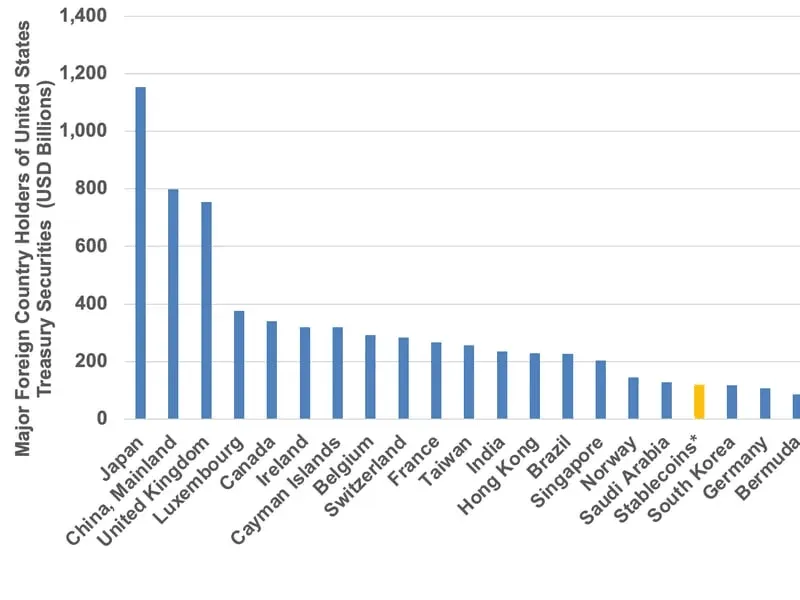
But Sky is one of the few, if not the only, protocol that uses these revenues to support the value of its native token, whereas privately held companies like Tether are simply keeping the profits generated.
Through a mechanism called the 'Smart Burn Engine', which functions similarly to a stock buyback, the protocol uses a portion of its revenues to purchase SKY on the open market. These tokens are then provided as liquidity on the decentralized exchange (DEX) Uniswap.
This mechanism not only creates buy pressure in the short term but also reduces sell pressure in the long run while simultaneously building deep liquidity for the token. For illustration and historical comparison, the chart below highlights the correlation between MakerDAO’s revenues and MKR, the token used prior to MakerDAO’s rebranding:
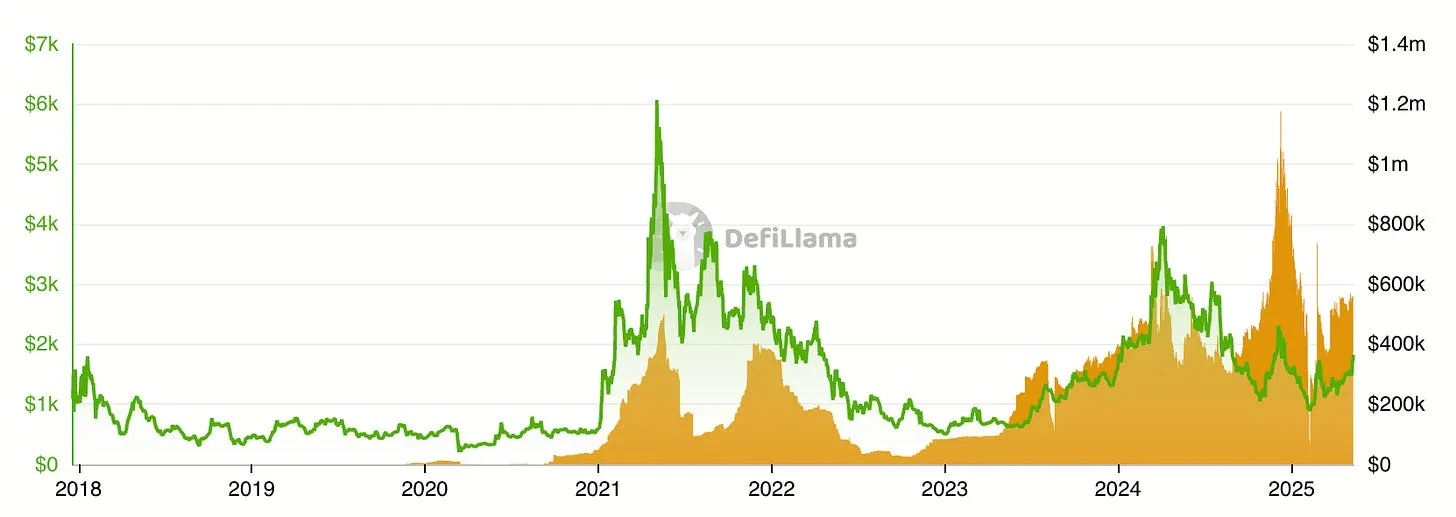
Although it is obviously naive to attribute the token’s performance solely to the protocol’s revenues, it is evident that the price of MKR is closely tied to Maker’s earnings.
This correlation makes it easier for traditional investors to evaluate the value and future potential of the protocol.
8.5 Final Considerations
There is a clear rationale behind Blockwall’s decision to structure its new fund as a pre-seed and seed-stage, Web3-focused venture capital fund with a hybrid approach, designed to capture both equity-only and token-exposed illiquid investments.
We believe that investing across both types of instruments is essential to comprehensively cover the entire Crypto and Web3 landscape. The equity-only model allows for long-term alignment with founders and traditional exit optionality, while token-exposed structures provide a mechanism to participate in native Web3 value creation, offering liquidity profiles and exit timelines not available in conventional venture capital.
This hybrid model also improves our ability to optimize fund performance. Token-exposed investments typically unlock earlier liquidity through vesting schedules following a Token Generation Event (TGE), allowing distributions to investors long before an M&A or IPO scenario would be feasible. At the same time, equity-only positions preserve exposure to foundational businesses where token models may not be relevant.
That said, we are mindful of the risks. Encouraging startups to issue tokens prematurely can cause misalignment between founders, users, and investors. It can distract from core product development or achieving product-market fit, similar to a company going public too early. We believe tokens are powerful tools when executed thoughtfully: they enable user participation, create new monetization pathways, and align incentives between teams, communities, and early backers. But they must serve the company’s mission, not the other way around.
Our responsibility as investors is to help founders balance short-term liquidity considerations with long-term strategic success. With close to a decade of experience navigating token models, venture scaling, and regulatory complexity, we are well-positioned to support this balance.
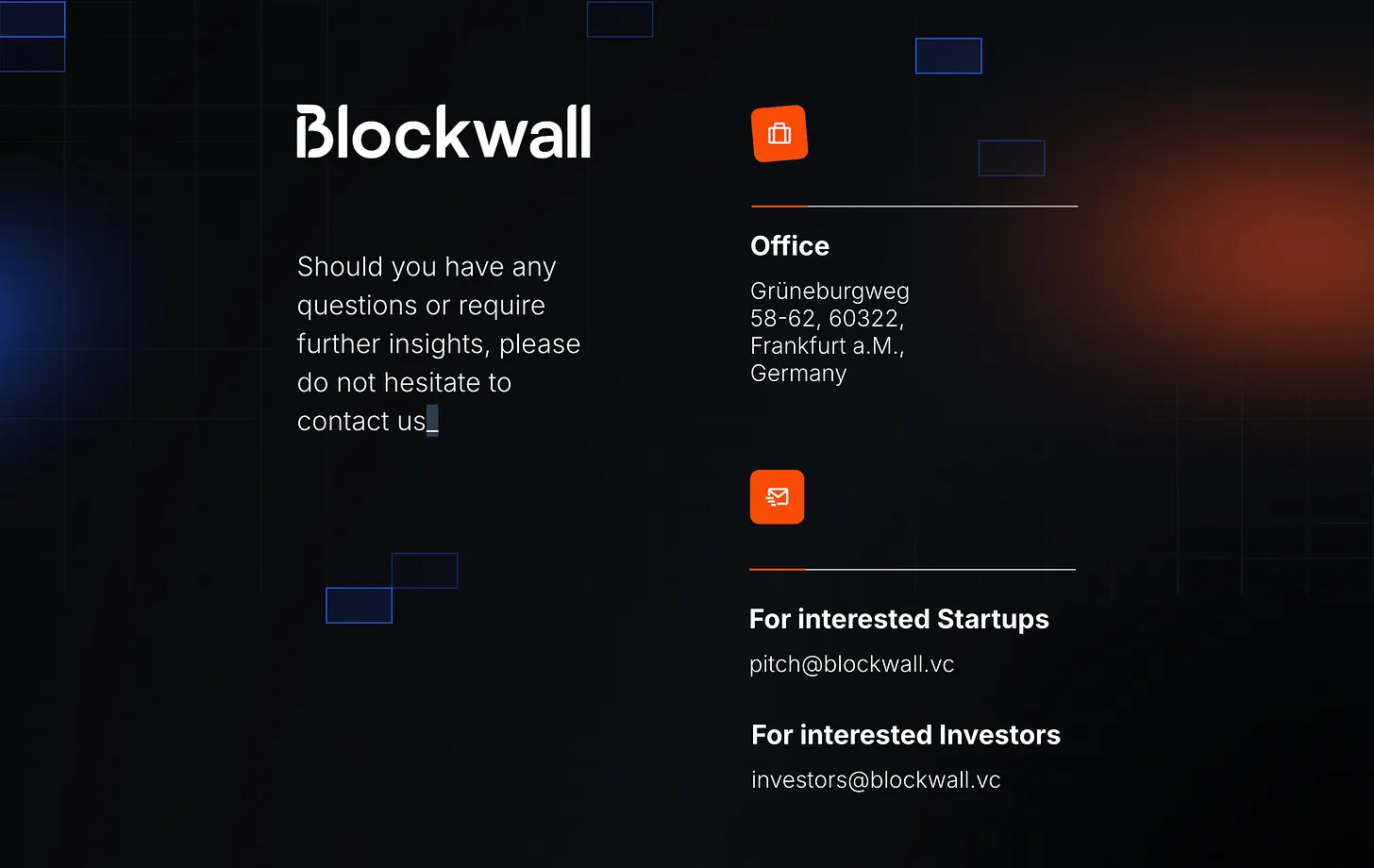
Disclaimer
To avoid any misinterpretation, nothing in this blog should be considered as an offer to sell or a solicitation of interest to purchase any securities advised by Blockwall, its affiliates or its representatives. Under no circumstances should anything herein be interpreted as fund marketing materials for prospective investors considering an investment in any Blockwall fund. None of the data and information constitutes general or personalized investment advice and only represents the personal opinion of the author. The author and/or Blockwall may directly or indirectly be exposed to the mentioned assets/investments. For further information please view the full Disclaimer by clicking the button below.
This work is licensed under the Creative Commons Attribution – No Derivatives 4.0 International License. CC BY-ND 4.0 Legal Code | Creative Commons